Recent Fire Damage Posts
Kitchen fire clean up
1/31/2024 (Permalink)
Grease fires can leave behind a stubborn and pervasive enemy: soot. Tackling this aftermath requires precision and expertise to restore your kitchen to its former glory. When it comes to soot cleanup, SERVPRO of Brown County stands out as the go-to vendor for a multitude of reasons.
Soot, a byproduct of incomplete combustion, can coat surfaces with a thick, black residue, jeopardizing your home's air quality. SERVPRO's trained professionals employ cutting-edge techniques and state-of-the-art equipment to efficiently remove soot, minimizing health risks and preventing secondary damages.
Choosing SERVPRO of Brown County ensures not just cleanliness, but also peace of mind. Their rapid response, industry-certified technicians, and commitment to excellence make them the preferred vendor for swift and thorough soot cleanup after a grease fire. Trust SERVPRO of Brown County to transform your kitchen from a sooty disaster to a spotless haven.
Fire Damage
11/10/2021 (Permalink)
It is officially November!
Halloween is behind us, Thanksgiving and Christmas are still ahead, and while it might be too early for some to hear Christmas carols on the radio and in the stores, it’s NEVER to early to do some safety prep for the holiday season.
On Fridays this month we will take a look at some different safety considerations you might want to take before your celebrations begin.
For our first Holiday Prep Profile, we’re going to talk about fire extinguishers.
Why fire extinguishers? Well, according to the National Fire Protection Association, or NFPA (one of our favorite sources, don’tcha know!), cooking fires peak during the holiday season. The NFPA says the most cooking fires occur on Thanksgiving, then Christmas Day, then Christmas Eve. Oh, and cooking fires are the leading cause of home fires.
So, all those statistics are certainly reason enough to consider getting a fire extinguisher for your home before the holidays AND learn how to use it properly.
First and foremost, you’re going to want to choose the right fire extinguisher. There are several classes of them, which the NFPA describes:
- Class A – this is the most common extinguisher and can be used to put out fires on cloth, wood, rubber, paper and many plastics.
- Class B – this is used on fires involving flammable liquids like gasoline, grease and oil.
- Class C – this is used for fires that involved electrical appliances and tools that are plugged in.
- Class D – this is used on flammable metals and is typically only found in factories that work with those metals.
- Class K – this is used on fires that involve oils and animal fats INSIDE cooking appliances. These are typically only found in commercial kitchens; however, they are on the market for use in homes.
The NFPA advises choosing a fire extinguisher for your home that is multi-purpose and large enough to put out a small fire, but not so large that it is difficult to handle.
The association also recommends reading all of the fire extinguisher’s directions and becoming familiar with it as soon as you buy it. This way you’ll know how to use it if you need it.
And when it comes to using it, remember the acronym PASS:
- P – Pull the pin. Hold the nozzle away from you and release the locking mechanism.
- A – Aim Low. Point the extinguisher at the base of the fire.
- S – Squeeze. Squeeze the lever slowly and evenly.
- S – Sweep. Sweep the nozzle from side-to-side.
The NFPA WARNS a fire extinguisher should ONLY be used if the fire is contained to a SMALL area, is NOT growing and the room is NOT filled with smoke. Otherwise, it is far too dangerous to try to put out a fire using an extinguisher and you should leave the home immediately. And, the NFPA says, you should always call the fire department.
A fire extinguisher is certainly a good tool to have in your home, particularly around the holiday season. However, it is not the be-all or end-all for fire safety. Take care of yourself and always put your safety first.
Candle Safety Tips
10/12/2021 (Permalink)
 Candle Fire
Candle Fire
Candle fire facts:
Candles caused 2% of reported home fires, 3% of home fire deaths, 6% of home fire injuries, and 4% of the direct property damage in home fires. Roughly one-third (37%) of home candle fires started in bedrooms. These fires caused 40% of the associated deaths and 49% of the associated injuries.
Candle Safety Tips
- Blow out all candles when you leave the room or go to bed. Avoid the use of candles in the bedroom and other areas where people may fall asleep.
- Keep candles at least 12 inches away from anything that can burn.
- Use candle holders that are sturdy, and won’t tip over easily.
- Put candle holders on a sturdy, uncluttered surface.
- Light candles carefully. Keep your hair and any loose clothing away from the flame.
- Don’t burn a candle all the way down — put it out before it gets too close to the holder or container.
- Never use a candle if oxygen is used in the home.
- Have flashlights and battery-powered lighting ready to use during a power outage. Never use candles.
Also, another option that is now a trending item, is the aromatherapy diffusers using essential oils. There are so many different scented oils that you can change up for each season!
The team at SERVPRO of Brown County knows all about the aftermath resulting from accidental fires. That is why you need to know the place your family calls home is in great hands when we get involved in the restoration process.
As a locally owned and operated business, we are strategically located to respond quickly to your smoke or fire damage event. If you have any questions about our services or need immediate assistance, call us today at (920) 434-8224.
Kitchen Fire Prevention
10/7/2021 (Permalink)
Cooking fires are the number one cause of home fires in the United States and the dangers only rise as we get into the holiday season. So, (since October is Fire Prevention Month) now is a good time to learn more about these incidents and what you can do to prevent them.
The statistics when it comes to kitchen fires are stark. According to the National Fire Protection Association (NFPA), cooking accounts for about 47% of home fires, 20% of fire-related deaths and 45% of the fire-related injuries reported across the country each year. The NFPA says Thanksgiving is the peak day for home cooking fires, followed by Christmas Day and then Christmas Eve.
Luckily, there are many simple steps home chefs can take to avoid these fires. One big step? Always watch what you’re cooking. The NFPA tells us one third of kitchen fires happen when a person leaves the equipment they’re using unattended. So, particularly if you’re using the stove top, stay in the kitchen and watch closely. If you’re using the oven, experts advise checking in regularly.
It’s important to remember, kitchen fires don’t just happen when food burns, anything flammable can catch fire if it’s too close to the heat. So, keep anything like oven mitts, dish cloths and paper towels AWAY from heat sources.
We have saved the BIGGEST culprit of cooking fires for last: frying. The NFPA says frying dominates the cooking fire problem. So, the Association has some advice you’ll want to follow this holiday season (and, of course, all year long):
- Always stay in the kitchen when frying.
- If you see smoke coming off the food you’re frying, turn off the burner or safely remove the pan from the burner. Smoke it a sign the oil is too hot.
- Slowly heat the oil to the temperature you need.
- Add food to the oil gently so that it does not splatter.
- Always keep a lid beside your pan. If the pan does catch fire, cover it with the lid and turn off the banner. Let the oil cool before removing the lid again.
- NEVER put water on a grease fire. If a fire starts to spread, leave the house immediately and call 911.
SERVPRO of Brown County is here to help 24/7. Call us at 920-434-8224
Preventing fire damage
10/1/2021 (Permalink)
A clothes dryer is one of those household conveniences most of us can’t imagine living without. But, if you’re not taking a few simple steps to ensure your dryer is safer, the machine could become a veritable tinder box.
Dryer lint is extremely flammable and if you’re not keeping your dryer clean and well-ventilated, you’re putting your home and yourself at risk.
According to FEMA 2,900 home dryer fires are reported yearly. Those fires cause an estimated 5 deaths, 100 injuries and $35 million in property damage each year.
FEMA says 34% of those fires are caused by failure to properly clean the dryer.
Luckily there are a few simple steps you can take to prevent dryer fires.
FEMA advises:
- Have the dryer installed by a professional in the first place.
- Clean the lint filter before and after each load of laundry and in between cycles, if it needs to run more than once.
- Clean the back of the dryer where lint can build up.
- Clean lint out of the vent pipe once every three months.
- If it’s taking longer than normal for clothes to dry, have a professional inspect it.
- Ensure the venting system behind the dryer is connected and un-damaged.
- Check regularly to make sure things like animal nests are not blocking the outside vent.
- Keep anything flammable away from the dryer.
- Do not leave the dryer running when you leave home or go to bed.
Something as small as a little bit of lint can be easy to overlook, but it can also have big consequences if you do.
So please keep your dryer clean and your home safe!
And should you experience a fire of any kind, remember, we are here to help with cleaning, recovery and reconstruction. Simply give SERVPRO of Brown County a call at 920-434-8224.
Fire Damage
7/29/2021 (Permalink)
A fire can be one of the most devastating events a home or business owner might face. Flames often start suddenly, move quickly and cause a lot of damage in a short amount of time. At SERVPRO of Brown County we understand how a fire can throw a person’s entire life into chaos. That’s why our team is prepared to bring order to that chaos.
SERVPRO technicians can provide cleanup of fire, smoke and soot damage. We have the training and specialized equipment to handle all size jobs. We are also able to provide reconstruction services.
Our team members recently took a Green Bay Area home that was nearly destroyed by a fire and worked tirelessly to completely clean and rebuild that home, making it something beautiful once again.
And when fires break out, it’s not just the flames that can cause damage. Often, the firefighting process leaves behind water. Our technicians can clean up any resulting water damage as well.
If a fire devastates your home or business, you can count on us to calm the chaos.
Have Questions? Call Us Today – (920) 434-8224
Plan, Prevent, Protect
7/1/2021 (Permalink)
PLAN, PREVENT, PROTECT
Here are a few ways to prevent a fire:
Install smoke alarms on every level of your home, inside bedrooms and outside sleeping areas.
Test smoke alarms every month. If they’re not working, change the batteries.
Talk with all family members about a fire escape plan and practice the plan twice a year.
If a fire occurs in your home, GET OUT, STAY OUT and CALL FOR HELP. Never go back inside for anything or anyone.
Fire Safety Basics:
# 1 Cause of fires is cooking.
- Don’t cook if you are tired.
- Don’t cook while drinking alcohol.
- If a fire starts, put a cover on the fire immediately.
- Call 911
For grease fires, there are a few extremely important things to remember:
- Do not use water
- Do not transfer the burning pot anywhere
- Only baking soda can be used, not any other baking materials
# 2 Portable Heaters
- Never leave a heater near clothes or a bare wall may cause a gradual build-up of heat that results in igniting the flammable object, piece of furniture, or wall.
- Be aware that heaters that use fuel (like kerosene) are more likely to cause a house fire than their electrical counterparts.
# 3 Candles
Candles account for 3% of all home fire deaths. Roughly one-third of all house fires started by candles are ignited in the bedroom. Twenty-one candle fires are reported per day, causing 6% of home fire injuries.
NEVER leave a candle unattended and always blow them out when leaving.
The team at SERVPRO of Brown County knows all about the aftermath resulting from accidental fires. That is why you need to know the place your family calls home is in great hands when we get involved in the restoration process.
As a locally owned and operated business, we are strategically located to respond quickly to your smoke or fire damage event. If you have any questions about our services or need immediate assistance, call us today at (920) 434-8224.
Clean your Dryer Vents
2/1/2021 (Permalink)
A clothes dryer is one of those household conveniences most of us can’t imagine living without. But, if you’re not taking a few simple steps to ensure your dryer is safer, the machine could become a veritable tinder box.
Dryer lint is extremely flammable and if you’re not keeping your dryer clean and well-ventilated, you’re putting your home and yourself at risk.
According to FEMA 2,900 home dryer fires are reported yearly. Those fires cause an estimated 5 deaths, 100 injuries and $35 million in property damage each year.
FEMA says 34% of those fires are caused by failure to properly clean the dryer.
Luckily there are a few simple steps you can take to prevent dryer fires.
FEMA advises:
- Have the dryer installed by a professional in the first place.
- Clean the lint filter before and after each load of laundry and in between cycles, if it needs to run more than once.
- Clean the back of the dryer where lint can build up.
- Clean lint out of the vent pipe once every three months.
- If it’s taking longer than normal for clothes to dry, have a professional inspect it.
- Ensure the venting system behind the dryer is connected and un-damaged.
- Check regularly to make sure things like animal nests are not blocking the outside vent.
- Keep anything flammable away from the dryer.
- Do not leave the dryer running when you leave home or go to bed.
Something as small as a little bit of lint can be easy to overlook, but it can also have big consequences if you do.
So please keep your dryer clean and your home safe!
And should you experience a fire of any kind, remember, we are here to help with cleaning, recovery and reconstruction. Simply give SERVPRO of Brown County a call at 920-434-8224.
Candle Safety Tips
11/10/2020 (Permalink)
Did you know the top 3 days for home candle fires are New Year’s Day, Christmas, and New Year’s Eve?
As enjoyable as it is to decorate during the holiday season, utilizing candles to add more seasonal flare throughout your home or for ceremonial/religious practices could potentially put your home at a higher risk for a fire.
The following are helpful tips on how to avoid a fire mishap from happening in your residence.
- Blow out all candles when you leave the room or go to bed. Avoid the use of candles in the bedroom and other areas where people may fall asleep.
- Keep candles at least 1 foot (30 centimeters) away from anything that can burn.
- Consider using battery-operated flameless candles, which can look, smell, and feel like real candles.
- If you do use lit candles, make sure they are in stable holders and place them where they cannot be knocked down easily.
- Keep your hair and any loose clothing away from the flame.
- Don’t burn a candle down — put it out before it gets too close to the holder or container.
- Never use a candle if oxygen is used in the home.
- Have flashlights and battery-powered lighting ready to use during a power outage. Never use candles.
Decking the halls should be fun, but always remember to exercise more caution when using candles.
The team at SERVPRO of Brown County knows all about the aftermath resulting from accidental fires. That is why you need to know the place your family calls home is in great hands when we get involved in the restoration process.
As a locally owned and operated business, we are strategically located to respond quickly to your smoke or fire damage event. If you have any questions about our services or need immediate assistance, call us at (920) 434-8224.
Fire Safety for Kids
10/13/2020 (Permalink)
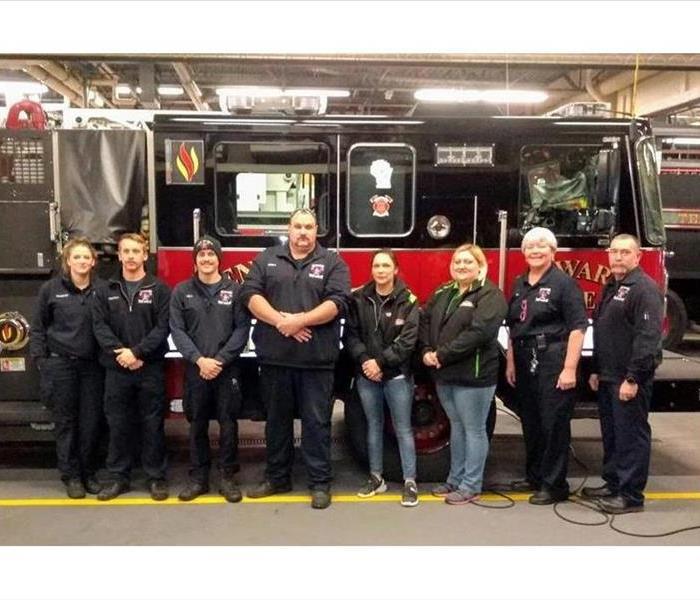 Howard Fire Fighters
Howard Fire Fighters
Fire Safety for Kids
Protecting and educating your children!
A home fire is a devastating event, and one that you never count on happening. Your children are most at risk when this disaster occurs. In fact, children under five are twice as likely as other people to die in a home fire. Tragically, many home fires are started by children playing with dangerous household items – especially lighters and matches. Taking sensible precautions in the home and teaching your child how to escape from a fire can help your family avoid this type of heartbreak.
Help Your Child Survive a Fire
- Install smoke alarms on every level of your home, inside bedrooms and outside sleeping areas.
- Once a month check whether each alarm in the home is working properly by pushing the test button.
- Replace batteries in smoke alarms at least once a year. Immediately install a new battery if an alarm chirps, warning the battery is low.
- Teach your children what smoke alarms sound like and what to do when they hear one.
- Ensure that all household members know two ways to escape from every room of your home, and where to meet up outside.
- Practice your fire escape plan at least twice a year and at different times of the day. Practice waking up to smoke alarms, low crawling and meeting outside. Make sure everyone knows how to call 9-1-1.
- Emphasize “get out, stay out.” Only professional firefighters should enter a building that is on fire—even if other family members, pets or prized possessions are inside.
- Use quick-release devices on barred windows and doors. Security bars without release devices can trap you in a deadly fire. If you have security bars on your windows, be sure one window in each sleeping room has a release device.
- Consider getting escape ladders for sleeping areas on the second or third floor. Learn how to use them, and store them near the windows.
- Teach household members to STOP, DROP and ROLL if their clothes should catch on fire.
SERVPRO of Brown County is locally owned and operated business, we are strategically located to respond quickly to your smoke or fire damage event. If you have any questions about our services or need immediate assistance, call us today at (920) 434-8224.
October Fire
10/8/2020 (Permalink)
Fires can be especially devastating to your home or business. After the fire trucks leave, your property will likely suffer from not only fire and smoke damage, but also widespread water damage and flooding from firefighting efforts. SERVPRO of Brown County Professionals have specialized fire and water damage restoration training and experience to quickly clean up and restore your home to pre-fire condition. They also can remove the pervasive smoke odor and deep-clean soot from upholstery and carpet.
The Fire Damage Restoration Process
SERVPRO of Brown County Professionals know just how devastating a fire can be. Fire and water damage can leave your house unsafe and unlivable. They’re trained to clean and restore your home with as little disruption as possible. Learn more about the fire damage restoration process.
Step1: Emergency Contact
Step 2: Inspection and Fire Damage Assessment
Step 3: Immediate Board-Up and Roof Tarp Service (if needed)
Step 4: Water Removal and Drying (if water damage is present)
Step 5: Removal of Smoke and Soot from All Surfaces
Step 6: Cleaning and Repair
Step 7: Restoration
Safety Tips
- Install smoke and carbon monoxide alarms on every level and in every room.
- Test alarms regularly
- Alarms don’t last forever, remember to replace your alarms every 10 years.
- Unattended cooking is the #1 cause of fires in the kitchen.
- Plan and practice an escape route with your family.
- If your smoke or carbon monoxide alarm sounds, leave the home immediately for fresh air and call 911
SERVPRO of Brown County is locally owned and operated business, we are strategically located to respond quickly to your smoke or fire damage event. If you have any questions about our services or need immediate assistance, call us today at (920) 434-8224.
Candle Safety Tips
10/2/2020 (Permalink)
Candle Safety Tips
With the upcoming holiday season approaching, we all enjoy decorating with candles!
As enjoyable as it is to decorate during the holiday season, utilizing candles to add more seasonal flare throughout your home or for ceremonial/religious practices could potentially put your home at a higher risk for a fire.
Candle Fires by the Numbers
- Candles caused 3% of reported home fires, 3% of home fire deaths, 6% of home fire injuries, and 5% of the direct property damage in home fires.
- Roughly one-third (36%) of home candle fires started in bedrooms. These fires caused 32% of the associated deaths and 47% of the associated injuries.
- Falling asleep was a factor in 11% percent of the home candle fires and 30% of the associated deaths.
- On average, 25 home candle fires were reported per day.
- More than half (58%) of home candle fires occurred when some form of combustible material was left or came too close to the candle.
- December is the peak time of year for home candle fires. In December, 11% of home candle fires began with decorations compared to 4% the rest of the year.
Here are a few safety tips:
Candle Safety Tips
- Blow out all candles when you leave the room or go to bed. Avoid the use of candles in the bedroom and other areas where people may fall asleep.
- Keep candles at least 12 inches away from anything that can burn.
- Use candle holders that are sturdy, and won’t tip over easily.
- Put candle holders on a sturdy, uncluttered surface.
- Light candles carefully. Keep your hair and any loose clothing away from the flame.
- Don’t burn a candle all the way down — put it out before it gets too close to the holder or container.
- Never use a candle if oxygen is used in the home.
- Have flashlights and battery-powered lighting ready to use during a power outage. Never use candles.
When it comes to candles, never under any circumstances, leave a child alone in a room with a burning candle. Keep matches and lighters up high and out of children’s reach in a locked cabinet. Their curious little minds tend to be attracted to the colorful flames. Supervision is vital for them not to burn themselves or to cause an unexpected fire hazard in your home.
The team at SERVPRO of Brown County knows all about the aftermath resulting from accidental fires. That is why you need to know the place your family calls home is in great hands when we get involved in the restoration process.
As a locally owned and operated business, we are strategically located to respond quickly to your smoke or fire damage event. If you have any questions about our services or need immediate assistance, call us today at (920) 434-8224.
When it comes to candles, never under any circumstances, leave a child alone in a room with a burning candle. Keep matches and lighters up high and out of children’s reach in a locked cabinet. Their curious little minds tend to be attracted to the colorful flames. Supervision is vital for them not to burn themselves or to cause an unexpected fire hazard in your home.
The team at SERVPRO of Brown County knows all about the aftermath resulting from accidental fires. That is why you need to know the place your family calls home is in great hands when we get involved in the restoration process.
As a locally owned and operated business, we are strategically located to respond quickly to your smoke or fire damage event. If you have any questions about our services or need immediate assistance, call us today at (920) 434-8224.
Have flashlights and battery-powered lighting ready to use during a power outage. Never use candles.
Kitchen Fire Safety Tips
7/29/2020 (Permalink)
Cooking fires are the number one cause of home fires in the United States and the dangers only rise as we get into the holiday season. So, (since October is Fire Prevention Month) now is a good time to learn more about these incidents and what you can do to prevent them.
The statistics when it comes to kitchen fires are stark. According to the National Fire Protection Association (NFPA), cooking accounts for about 47% of home fires, 20% of fire-related deaths and 45% of the fire-related injuries reported across the country each year. The NFPA says Thanksgiving is the peak day for home cooking fires, followed by Christmas Day and then Christmas Eve.
Luckily, there are many simple steps home chefs can take to avoid these fires. One big step? Always watch what you’re cooking. The NFPA tells us one third of kitchen fires happen when a person leaves the equipment they’re using unattended. So, particularly if you’re using the stove top, stay in the kitchen and watch closely. If you’re using the oven, experts advise checking in regularly.
It’s important to remember, kitchen fires don’t just happen when food burns, anything flammable can catch fire if it’s too close to the heat. So, keep anything like oven mitts, dish cloths and paper towels AWAY from heat sources.
We have saved the BIGGEST culprit of cooking fires for last: frying. The NFPA says frying dominates the cooking fire problem. So, the Association has some advice you’ll want to follow this holiday season (and, of course, all year long):
- Always stay in the kitchen when frying.
- If you see smoke coming off the food you’re frying, turn off the burner or safely remove the pan from the burner. Smoke it a sign the oil is too hot.
- Slowly heat the oil to the temperature you need.
- Add food to the oil gently so that it does not splatter.
- Always keep a lid beside your pan. If the pan does catch fire, cover it with the lid and turn off the banner. Let the oil cool before removing the lid again.
- NEVER put water on a grease fire. If a fire starts to spread, leave the house immediately and call 911.
Now you know a little bit more about how to stand the heat and stay in the kitchen SAFELY. And in any unfortunate event that you may need help with clean up, give SERVPRO of Brown County a call at 920-434-8224
What Should You do After a Fire Disaster Affects Your Home
7/14/2020 (Permalink)
An unexpected house fire in the West Brown County area could be a very traumatic and unsettling experience for your family. Having to deal with the aftermath can leave anyone feeling uncertain about the future of the place they call home. Where does one start once the smoke as settled, and are now faced with making decisions you never thought possible?
At SERVPRO of Brown County we understand how a fire can throw a person’s entire life into chaos. That’s why our team is prepared to bring order to that chaos.
SERVPRO technicians can provide cleanup of fire, smoke and soot damage. We have the training and specialized equipment to handle all size jobs. We are also able to provide reconstruction services.
Do keep in mind, water damage is typical if water hoses were used to put out the fire. Your possessions could end up soggy. Anything you want to preserve, or reuse will need careful cleaning. When you have a critical cleanup situation, it is best to take immediate action and hire professionals that specialize in both fire and water restoration services.
SERVPRO of West Brown County specializes in fire and water restoration. We've received advance training in restoration techniques, and we have the experience and specialized equipment to restore your property quickly.
Our Technicians train in the following areas:
- Fire & Smoke Restoration
- Odor Control
- Upholstery & Fabric Cleaning
- Water Damage Restoration Technician
We are a locally owned and operated business that is strategically located to respond quickly to your smoke or fire damage event. If you have questions about fire, smoke, or soot damage, call us today at (920) 434-8224.
SERVPRO of Brown County Fire Emergency Tips for Homeowners
2/5/2020 (Permalink)
As the temperatures continue to drop, we find ourselves utilizing our heat resources more often. With running your space heaters, furnaces, or wood stoves at all hours of the day, the potential of fire rises. The team from SERVPRO of Brown County recommends compiling a list of emergency contacts in the event of any accidental disasters. Taking this action not only could save a lot of stress off of you and your entire household but have you more prepared if there were to be an unfortunate turn of events due to a fire emergency.
Some of the essential information you could include in your emergency contact information list are the following:
- Names, ages and birth dates of each family member: to eliminate any confusion about first responders wanting to ensure every person is accounted for.
- Home address and telephone number: include the address of the where the list resides, include full street address, and your phone number with area code.
- Names and Phone Numbers for your insurance agency: the agent you have your policy through or company that would deal with any claim that needed to be filed.
- Local contact: someone close-by-neighbor, relative, or landlord.
- Relative or person who would be designated as an emergency contact: this person could make vital decisions for you if necessary.
- Work contact: your boss or supervisor, or a close co-worker.
- Family Physician and hospital: your doctor’s full name and office number with an after-hours office or pager number as well, plus a non-emergency number for your local hospital.
- Police/Ambulance: 911 in most locations, but it may be different; it also includes non-emergency numbers.
- Fire department: 911 in most locations, but that may be different in your area; include non-emergency numbers.
- Gas company: contact information for emergencies.
- Electric company: contact info for emergency situations.
- Other utility companies: emergency contact information
- List of Special conditions and equipment/medication: list (by a family member) special medical conditions, including allergies, and specific medications such as insulin, inhalers, Epi-pens, etc., as well as important and necessary medical equipment such as blood pressure monitors, blood glucose testing machines, CPAP machines and such.
- Health care / health insurance information: contact info for your insurance company or provincial/state health coverage providers, as well as personal health numbers (PHNs), insurance policy and group numbers for each person in the home.
Another great resource to have on hand is the American Red Cross Picking Up the Pieces After a Fire Guide. They highly suggest the following tasks be done immediately after a home fire.
- Call 9-1-1. Give first aid where needed; cool and cover burns to reduce the chance of further injury or infection.
- Let friends and family know you’re safe.
- People and animals that are seriously injured or burned should be transported to professional medical or veterinary help immediately.
- Stay out of fire-damaged homes until local fire authorities say it is safe to re-enter.
Fires are capable of destroying anything in its path, but there are also times that the damage is manageable, especially with the help of the right restoration professionals.
After the fire trucks leave, your home likely suffers from fire and smoke damage and extensive water damage from firefighting efforts. SERVPRO of Brown County has the specialized fire restoration training needed to restore your home to pre-fire conditions.
We have technicians on call 24 hours a day, 7 days a week, ready to go into action when they are needed. Give us a call at (920) 434-8224.
Candle Safety Tips to Avoid Holiday Mayhem
11/29/2019 (Permalink)
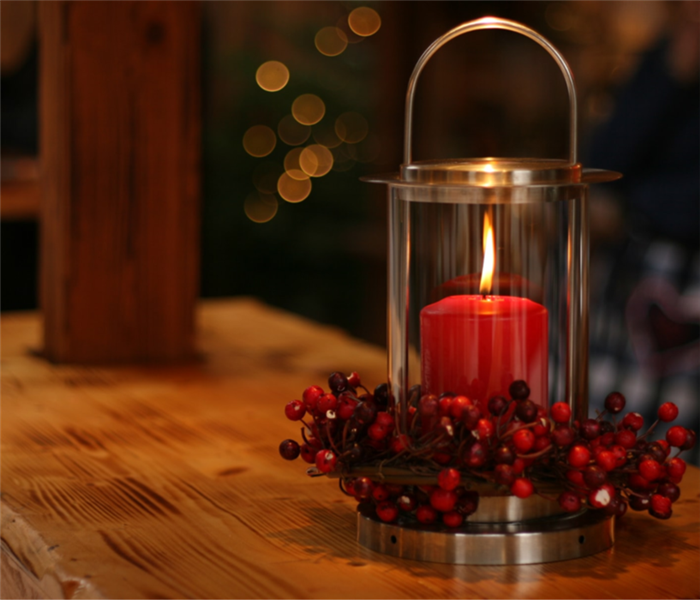 A clear glass hurricane candle holder with a red candle and holly berry wreath serves as a holiday centerpiece.
A clear glass hurricane candle holder with a red candle and holly berry wreath serves as a holiday centerpiece.
Did you know the top 3 days for home candle fires are New Year’s Day, Christmas, and New Year’s Eve?
As enjoyable as it is to decorate during the holiday season, utilizing candles to add more seasonal flare throughout your home or for ceremonial/religious practices could potentially put your home at a higher risk for a fire.
From a statistical standpoint, on average, 23 home candle fires are reported each day. What’s even more alarming is from 2012-2016, U.S. fire departments responded to an estimated 8,200 home structure fires that were started by candles per year. These fires caused 770 injuries and $264 million in direct property damage.
There are a variety of ways to avoid becoming one of those startling statistics.
The following are helpful tips on how to avoid a fire mishap from happening in your residence.
- Blow out all candles when you leave the room or go to bed. Avoid the use of candles in the bedroom and other areas where people may fall asleep.
- Keep candles at least 1 foot (30 centimeters) away from anything that can burn.
- Consider using battery-operated flameless candles, which can look, smell, and feel like real candles.
- If you do use lit candles, make sure they are in stable holders and place them where they cannot be knocked down easily.
- Keep your hair and any loose clothing away from the flame.
- Don’t burn a candle down — put it out before it gets too close to the holder or container.
- Never use a candle if oxygen is used in the home.
- Have flashlights and battery-powered lighting ready to use during a power outage. Never use candles.
When it comes to candles, never under any circumstances, leave a child alone in a room with a burning candle. Keep matches and lighters up high and out of children’s reach in a locked cabinet. Their curious little minds tend to be attracted to the colorful flames. Supervision is vital for them not to burn themselves or to cause an unexpected fire hazard in your home.
Decking the halls should be fun, but always remember to exercise more caution when using candles.
The team at SERVPRO of West Brown County knows all about the aftermath resulting from accidental fires. That is why you need to know the place your family calls home is in great hands when we get involved in the restoration process.
As a locally owned and operated business, we are strategically located to respond quickly to your smoke or fire damage event. If you have any questions about our services or need immediate assistance, call us today at (920) 434-8224.
Appliance Safety for the Thanksgiving Holidays
11/12/2019 (Permalink)
Thanksgiving is just around the corner. That means it time for those holiday dishes to make their appearance across dining room tables everywhere. While most people are concerned about having enough food to feed their guests, they tend to forget about paying attention to other details like putting a larger than usual strain on the appliances used to cook their holiday feast.
Chances are your oven will be the one appliance with an increased workload.
Other common appliances like your microwave or slow cooker may also play some role in food preparation.
Whatever you're baking, you'll want to make sure all of the electrical connections have been inspected to ensure proper functionality. Always make sure the power is off and use caution when working near anything electrical.
By taking the time to do a quick inspection, like looking over the oven coils, you could save a kitchen disaster from happening over the holiday season. Even after your family and friends have feasted on your Thanksgiving meal, you'll want to be sure that the coils didn't take any damage.
Depending on your setup, your stove may be right above your oven, or it may be on the other side of the kitchen. It's a good idea to go ahead and make sure all four burners are in good working order, whether they're gas or electric. If you ever suspect a gas leak, it's always best to call a professional to get this fixed immediately!
Everyone's cooking habits and skills are different, but one thing is certain. The microwave gets used regularly to save time. Just like your oven, there are a few things you'll want to check to get ready for the holidays.
As with the oven, inspect all electrical connections to be sure nothing is loose. It's possible one or more of these connections could have come loose during use. After you've checked for loose connections, take a look at the door of the microwave, as well as the turntable. The door should not be loose, and it should close properly. If your door is falling off, or not shutting completely, it is probably time to get a new microwave. Your turntable should be free of any damage and shouldn't wobble when it's rotating.
When it comes to your slow cooker, make sure to check both ends of the cord for any frayed or exposed wires. If you spot any, cut the cord and dispose of your appliance immediately — black tape is not a safe remedy. Though slow cookers have been around for a long time, technology has improved a lot in recent years — older models don't offer modern safety features like auto-shutoff. If you notice any off odors or see that the exterior of your slow cooker feels hotter than it should when in use, unplug it right away and toss it. If there's a chance your slow cooker has spent time in someone's garage, you should probably consider upgrading.
SERVPRO of West Brown County wants you to have a worry-free Thanksgiving. In the event a faulty appliance causes an unexpected fire emergency in your home, know that we are available 24 hours a day, 7 days a week to answer the call should you need restoration help following fire damage.
Our technicians are highly trained and ready to take on any project to get your life back in order. Give us a call us at (920) 434-8224.
Teaching Kids the Essentials of Fire Safety and Extinguisher Use
11/7/2019 (Permalink)
With the holiday season in full swing, most kids and teens will be spending a few days at home during their Thanksgiving school break.
Teaching adolescents to prepare and cook their meals with various kitchen appliances like a toaster oven or microwave shouldn’t cause too much concern for parents; however, there are those unexpected moments when things could go suddenly wrong. Whether its siblings watching out for one another or a babysitter caring for your kids during that vacation break, it is essential to go over emergency procedures with any individuals that will be in your household in the event of an unexpected fire.
The very first step towards fire prevention is awareness about fire and precautionary measures. It’s not enough if you alone learn about fire prevention. Children need to possess a basic knowledge of dealing with fire breakouts. They need to learn about the different types of firefighting techniques, especially those adopted for small homes. Dousing the flames with the right kind of fire extinguisher is also essential. For instance, you can’t extinguish electrical fires with water and would instead need a Class C rated fire extinguisher.
The ability of your kids to help you douse the flames and at times, even handling fire extinguishers all by themselves is subject to proper training and awareness about firefighting. You can’t leave your kids to the mercy of any size of flames. Instead, train them to deal with fire breakouts by learning about fire prevention. Your kids need to learn about the PASS method for handling small fire and dousing the flames with home fire extinguishers. Here is a training method developed to deal with fires.
Your kids need to remember the PASS method while using the fire extinguisher:
P – pulling the extinguisher pin
A – aiming the fire extinguisher low
S – squeezing the handle
S – sweeping the extinguisher sidewise
Besides just using your home fire extinguishers, you need to train your kids on how to prevent fires, as well. You need to inform them about not leaving any flammable items like gas cylinders in front of flames or fire and ensure that the easily accessible appliances they use are switched off and unplugged before it is left unattended. You also need to tell them to call the emergency fire service; they notice flames in any corner of your residence.
Avoiding scenarios that could lead to fires breaking out minimizes the chances of an actual fire taking place. Your kids can play a vital role in preventing accidental fires just by learning about the prevention techniques and even handling home fire extinguishers efficiently.
At SERVPRO of Brown County, we know that despite taking precautionary measures to avoid a home disaster from transpiring, fires still take place.
Certain circumstances require someone knowledgeable in various levels of the restoration process. Our staff is highly trained in property damage restoration. From initial and ongoing training at SERVPRO’s Corporate Training Facility to regular IICRC industry certifications, rest assured our team is equipped with the knowledge to restore your property. Our training program includes the following:
- IICRC Training
- Employee Certification Training
- Initial Franchise Training
- e-Learnings
- Continuing Education Classes
If you have any questions or need our services, give us a call at (920) 434-8224.
Fire Prevention Month: What Should You do After a Fire Disaster Affects Your Residence
10/29/2019 (Permalink)
An unexpected house fire in the West Brown County area could be a very traumatic and unsettling experience for your family. Having to deal with the aftermath can leave anyone feeling uncertain about the future of the place they call home. Where does one start once the smoke as settled, and are now faced with making decisions you never thought possible?
One of the critical factors about your living quarters is knowing whether it is safe to enter after a fire. As a rule of thumb, it is best to wait until the professionals called in to extinguish the fire and inspect the structure, state it is fine to do so.
Knowing who to call after a fire is equally important. Don't assume that someone is going to contact your insurance. This will not only enable documentation of the event and set in train the insurance claim, but your insurer will be able to talk you through emergency lodging and living expenses. Remember to retain all receipts to make a claim. The insurance company will also assist with clean up options.
Depending on your housing situation, you may need to contact additional people, especially if you are a tenant. The owner/landlord needs as much information that you can offer them for their insurance company to process the claim that will get you back into the place you call home sooner than later.
If your place only sustained damage rather than being destroyed, an interior cleanup will be required. Be aware that destruction to the property often goes beyond what the eye can see. Some of those damages include soot, ash, charring, smoke, and odor.
The smoke alone is known to leave an undesirable odor on items from treasured belongings, to all thing's upholstery, and your clothing. Also, be aware that soot and smoke damage might be significant. It often creates a film on the walls. There will also be residue from the extinguishers used by the fire crew.
Do keep in mind, water damage is typical if water hoses were used to put out the fire. Your possessions could end up soggy. Anything you want to preserve, or reuse will need careful cleaning. When you have a critical cleanup situation, it is best to take immediate action and hire professionals that specialize in both fire and water restoration services.
SERVPRO of West Brown County specializes in fire and water restoration. We've received advance training in restoration techniques, and we have the experience and specialized equipment to restore your property quickly.
Our Technicians train in the following areas:
- Fire & Smoke Restoration
- Odor Control
- Upholstery & Fabric Cleaning
- Water Damage Restoration Technician
We are a locally owned and operated business that is strategically located to respond quickly to your smoke or fire damage event. If you have questions about fire, smoke, or soot damage, call us today at (920) 434-8224.
Fire Prevention Month: Wood Stove and Fireplace Safety
10/28/2019 (Permalink)
The climate in Wisconsin usually feels a handful of freezing temps a few short weeks before winter finally decides to set up camp in the Midwest and stick around for an extended period of several months.
Using a modern-day wood stove has many advantages over traditional models. The newer models use high-grade glass-ceramic on the front, which can withstand higher temperatures than other materials.
Even with a wood stove, people still enjoy the warmth generating from a fireplace. Whether it’s your primary or secondary source of heat, it’s important to always take extra safety measures against any fire emergencies.
To help you with some of those precautionary tasks, here are a few essential safety tips you can implement while using your fireplace or wood stove this winter.
Fireplace Safety:
- The best tactic for making sure your fireplace is safe to use for the winter season is to have regular visual inspections – both inside and out.
- If using a gas fireplace, make sure the flame burns blue. A yellow or orange flame is a sign that something is wrong, and that you need to contact a licensed technician immediately.
- Finally, always open the damper before lighting a fire. Don’t shut it until the ashes are cold to avoid the risk of a burn.
- Proper fireplace ventilation is essential to fireplace safety. When looking outside, be sure to inspect the chimney cap, since it keeps foreign objects out of your home while preventing hot embers from flying out of your chimney and on to your roof. You should also check above your fireplace to assess whether the mortar is intact and to ensure there is no physical damage.
- Check the integrity of the chimney plumb on the roof to make sure it has not begun to tip to one side. A tilting chimney is a sign of a bigger structural problem and requires immediate inspection.
- If you have household equipment that vents carbon monoxide, be sure not to run it while using your fireplace. Make sure the vents in each room of your house are open, as well. This will prevent any gas or fumes from getting trapped and accumulating inside a single room.
- Consider getting a fire screen. These areinexpensive and don’t require installation. Purchase your chosen screen and stand it in front of the fire. It’s a simple item, but it plays a considerable part in fire safety by shielding people, furniture, and carpets from errant sparks.
Wood-burning Stove Safety:
- Proper wood-burning stove maintenance is essential. One tip is to make sure to clean the wood stove properly to remove all ash before you use it for the first time in the winter, as well as before each subsequent use through the season.
- The chimney used with a wood-burning stove must be mason-built or manufactured in a factory. You cannot use metal chimneys or single-brick chimneys as they deteriorate and may pose a fire hazard over time. Older homes that have double-bricked chimneys should be inspected for any deterioration in the lining or loose mortar before using a wood-burning stove.
- If using coal in your stove, do not use a metal chimney as the fumes from that particular resource will corrode the metal almost instantly. In this case, your metal chimney will need to be uninstalled and inspected.
- Do not under any circumstances use a smoke duct that has previously been used with an oil burner. The unburned vapors will ignite backward into the wood-burning stove and your home.
- Your stove should always be on a stable surface.Unlike fireplaces, stoves can be positioned wherever you like. It’s crucial to position stoves on a durable, fireproof surface. Brick and tile are ideal places for a stove to rest. Regular maintenance, cleaning, and sensible precautions when choosing the wood and starting a fire, all contribute to fire and stove safety.
One last important matter is to make sure you are disposing of the ashes correctly. Many home fires are started because of fireplace ash. A buildup of ash can also shorten the life of the fireplace. Ashes must be raked out regularly – always use an ash shovel. If possible, wait 24 hours from when the fire burned out before raking the ashes. Store ashes in a metal ash bucket outside of the home, and away from fallen leaves, wood or kindling. Only transfer ashes to the trash when they have cooled down.
At SERVPRO of West Brown County, we understand with all of the precautions you take to ensure a safe environment within your home, unexpected emergencies can happen. If you end up with fire, smoke, or soot damage in your residence our trained technicians use the appropriate equipment, expertise, and experience to restore things.
We are available 24 hours a day, 7 days a week. Call us at, (920) 434-8224.
Fire Prevention Month: Keeping Your Home and Pets Safe from Electrical Fires
10/17/2019 (Permalink)
Having a cat or dog in your home means taking the time to safeguard certain areas of your residence to avoid your furry friend’s curious nature. What we view as an everyday household item, they tend to see as something to play with or a chew toy. A hyperactive dog or inquiring cat can easily cause an electrical hazard or fire in ways you may not have considered.
Here is a checklist to help you protect against your pets being in any danger of being hurt.
- To avoid any temptation on their part, keep electrical cords away from your pets, so they don’t chew on them and receive a severe shock. Cover the cord with a heavy plastic sleeve. Ask your pet store for a bitter-tasting product you could put on the cord.
- Check that your nightlights and appliances are completely plugged into wall outlets. Small paws, or tongues can easily find partially unprotected prongs and are a hazard for curious children, puppies, and kittens.
- Halogen lamps should never be used in play areas. Halogen bulbs can reach very high temperatures, and if knocked over during play, could quickly start a fire.
- All appliances near sinks or bathtubs should be plugged into an outlet equipped with a Ground Fault Circuit Interrupter (GFCI). Playful pets can knock radios, curling irons, and other items into the water, creating a dangerous situation. GFCIs stop the flow of electricity instantly if there is a problem, and when properly used, can save lives.
- Do not allow pets to curl up for a nap behind warm computer equipment. They need to learn to stay away from all electrical connections. If your pets are reluctant to cooperate, consider investing in baby gates to keep them away from your equipment.
The team over at SERVPRO of West Brown County wants your fury friends and house to remain safe at all times. If the unfortunate circumstances of an electrical fire arise, know that we respond quickly to your smoke or fire damage.
As a locally owned and operated business. We are strategically located to respond quickly to your emergency needs. Call us at, (920) 434-8224.
Fire Prevention Month: Basement Fires
10/10/2019 (Permalink)
Now that Fire Prevention Month is underway, SERVPRO of West Brown County would like to remind you there are several ways to prepare your household for unexpected fire emergencies.
This week's focus is on ways you can fire-safe your basement.
The basement is a room in the house that most people use as a secondary area to entertain guests, living quarters, or a site to store seasonal items. It could also be the one place in your house you may not spend that much time in; therefore, it would be a good idea to inspect the room for certain safety features that could contain a fire if one were to break out unexpectedly.
The following tips are helpful suggestions from the Federal Emergency Management Agency (FEMA):
Early Warning Devices
- Install a smoke alarm in the basement. Test the alarm each month and clean as needed. The basement smoke alarm should be connected to other smoke alarms in your home.
- If you have oil, gas or wood-burning equipment in the basement, you should also have a carbon monoxide alarm installed in the basement.
Utilities
- Maintain easy, quick access to your fuse box or circuit breaker panel.
- Keep the burner access doors on gas water heaters and gas furnaces closed to prevent flames from escaping and starting a fire.
Housekeeping
- Keep anything that can burn at least 3 feet from the furnace, oil burner, wood stoves, water heaters, and other heat-generating equipment.
- Keep oily rags in airtight containers and away from heat sources.
- Trash should not be stored in the basement.
- Washers and dryers should be plugged directly into wall outlets.
- Clean lint filters every time you use the dryer.
- Clean the dryer vent ductwork every year.
- Keep stairs free of clutter and safe for quick exit in an emergency.
The best thing you could do for your home and family is to practice these precautionary measures several times throughout the year.
In the event your basement was to catch fire, chances are certain areas of your home could also suffer from fire and smoke damage from firefighting efforts. SERVPRO of West Brown County wants you to know we have technicians specialized in fire restoration training that is needed to restore your basement to pre-fire conditions.
We have technicians on call 24 hours a day, 7 days a week, ready to go into action when they are needed. If you have questions about fire, smoke, or soot damage, call us today at (920) 434-8224.
October Kicks off Fire Prevention Month
10/4/2019 (Permalink)
Every month SERVPRO of West Brown County offers helpful tips on how your family can navigate through various emergencies.
October is nationally known as Fire Prevention Month. This month's prevention initiative intends to raise awareness about fire safety and home safety to help ensure your home and family are prepared in the case of an emergency. Think of this as a perfect opportunity to review the current plans your household has in place for any fire emergency that may unexpectedly arise.
Some interesting facts shared by First Alert include:
• 3 of every 5 home fire deaths resulted from fires in homes with no working smoke alarms.
• Less than 50% of homeowners have an escape plan.
• Carbon monoxide (CO) is the #1 cause of accidental death.
• 60% of consumers do not test their smoke and CO alarms monthly.
• Only 47% of people report having CO alarms in their homes.
• Just 43% of homeowners have an escape plan.
These are some pretty alarming statics!
The best way to get started on the process to protecting your loved ones is to do a thorough inspection and inventory of all of your fire extinguisher and smoke detectors. By checking your alarms, testing the alarms regularly, and adding reliable protection when replacing expired alarms urges the household to improve your home's safety.
It is not that all uncommon for anyone living under your roof to easily forget where each of these essential items are found. Making a detailed layout, then printing multiple copies to leave in designated areas in your house, is an excellent way for family members to refresh their memories on where each of these resourceful items resides. For the younger members of your family, consider using colorful graphics for them to relate to. A house scavenger hunt would be a fun way to educate and prepare your little ones to not be afraid in the event of a fire crisis.
Don't forget your pets! Include them in all of your emergency plans. Do this by having one or two members of your family designated to help your pets safely vacate your property.
Did you know SERVPRO of West Brown County's staff are highly trained in property damage restoration?
From the initial and ongoing training at SERVPRO's Corporate Training Facility to regular IICRC industry certifications, rest assured our staff is equipped with the knowledge to restore your property. Our training program includes the following:
• IICRC Training
• Employee Certification Training
• Initial Franchise Training
• e-Learnings
• Continuing Education Classes
Let us be the ones you turn to for all of your fire restoration needs. Give us a call at, (920) 434-8224.
Common causes of a house fire
7/15/2019 (Permalink)
Homeowners in our Green Bay community can do many things to prevent a house fire. In fact, most house fires can be prevented. When a fire occurs, it can damage and destroy many personal items as well as costing homeowners thousands in structural cleaning, deodorizing, and repairs. So, what are the most common cause of house fires and how can we prevent them?
Common causes of a house fire
Cooking
Most kitchens can become a potential fire hazard if left unsupervised. According to the National Fire Protection Association, unattended cooking was the leading cause of cooking fires and casualties. It’s a smart idea to always stay in the kitchen when frying, broiling, or grilling. Make sure loose clothing and towels are secured prior to cooking.
Smoking
Careless smoking is a real danger inside a home. You should not smoke if you are drowsy or taking a medication that affects your judgment. Make sure your cigarette is completely put off before throwing it away. A still lit cigarettes can easily start a fire. If you must smoke indoors, make sure your ashtray is deep and away from items that are flammable.
Candles
While candles are fun and smell nice, they are an open flame. You should always be in the same room if you have a candle burning. Never leave a candle burning when you are not home. Always keep candles away from children and pets. You may want to consider switching to candles powered by LED lights.
Did you know? The top three days for home candle fires are New Year’s Day, Christmas, and New Year’s Eve.
Heating equipment
Ideally, you should have your furnace (and chimney if you have one) equipment inspected yearly by a qualified technician. Out of all the heating equipment, space heaters are the leading heating equipment that cause fires. Keep space heaters at least 3 feet away from items such as curtains, bedding, or paper products. Ensure your smoke and carbon monoxide alarms are properly working by pushing the ‘test’ button on the alarm. Having a smoke alarm that is working can alert you and increase your chances of surviving a fire.
Here to help
A fire can be an emotional time for any homeowner, but we are here to help you through the process. We have the experience, knowledge, equipment and processes needed to effectively recover from a fire and it’s soot, smoke odor, and damage. SERVPRO of West Brown County ensures that you will be taken care in a time of need should a fire start in your home. You can call at any time (920) 434-8224.
Fire prevention: kitchen safety
7/11/2019 (Permalink)
Any kind of fire can be a devastating event. According to the National Fire Protection Association Thanksgiving is the peak day for home cooking fires, followed by Christmas Day and Christmas Eve. Kitchen fires can start rapidly but knowing what to do in case of a fire can help minimize further potential damage.
Here’s a few tips that can help prevent a fire:
If you’re boiling, or frying or cooking with high temperatures, you should stay in the kitchen to prevent any mishaps. Many fires we deal with are the result of people forgetting they have something cooking on the stove. Most fires start with a high temperature, if you notice smoke or the grease begins to boil, turn off the burner immediately.
- Clean your oven and stove top
Any lingering grease or foods can easily spark a fire. Make sure your stove top and oven are clean before cooking.
- Keep a fire extinguisher near
If a small fire has started, you may be able to control the flames with a small fire extinguisher. Also, keep a large pan lid around in case of a fire occurring. You may be able to snuff out a small fire in a pan by covering it with a lid to starve the fire of oxygen and put it out. If you feel like the fire is uncontrollable, evacuate everyone in your home and call 911.
- Double check your smoke alarm
Double check that your smoke alarms are functioning properly by testing them every six months. A good practice is to test the units and make sure the batteries are good or replaced when you adjust the clocks for daylight savings time in the spring and fall.
SERVPRO of West Brown County handles fire damage
By taking precautions now, you can help prevent future fire from happening in your home. SERVPRO of West Brown County is ready to help in case of any fire in your home and clean up any remaining soot and odor. SERVPRO of West Brown county will make your home look “Like it never even happened.” after a kitchen fire.
Fire prevention: keeping our pets safe
7/9/2019 (Permalink)
As much as we try to prepare ahead for the unexpected, an emergency may still happen. An estimated 500,000 pets are affected by fire annually. Thinking of all individuals in our family including pets can help minimize damage. Here at SERVPRO of West Brown County, we want to make sure your pets stay safe. We’ve gathered some helpful tips to make sure your pet stays safe ahead of a fire.
- Note where your pets like to sleep or nap. If there’s a fire and you cannot locate your pet right away, you may want to check the area where your pet loves to hang out or likes napping.
- Keep the address and phone number of your pet’s vet handy. If your pet does get hurt or injured, you’ll know exactly where to call.
- Pack your pet’s supplies in your emergency kit. If your family already has an emergency kit (a kit with all your family’s important items) don’t forget to add your pet’s id tags and any important documents concerning your pet.
- Pet proof your home. Most fires can be preventable. You can also help prevent a fire by keeping your pet away from fireplaces, stove tops, and candles.
- Make sure your smoke detectors are working. Double check that your smoke detectors are working as they should be. Keep extra batteries as a backup.
Fun Fact: Did you know July 15 is National Pet Fire Safety day?
Contact Us for your Fire Damage Needs
Here at SERVPRO of West Brown County, we love our pets. Boo, our owner’s pet loves to stop by occasionally to check in on employees. Checkout our Facebook page “SERVPRO of West Brown County” every Tuesday for updates on #BooDayTuesday! Remember if fire strikes your home, SERVPRO of West Brown County can help you recover and get back on your feet and make it look “Like it never even happened.”
Green Bay Area Smoke and Soot Cleanup
4/10/2019 (Permalink)
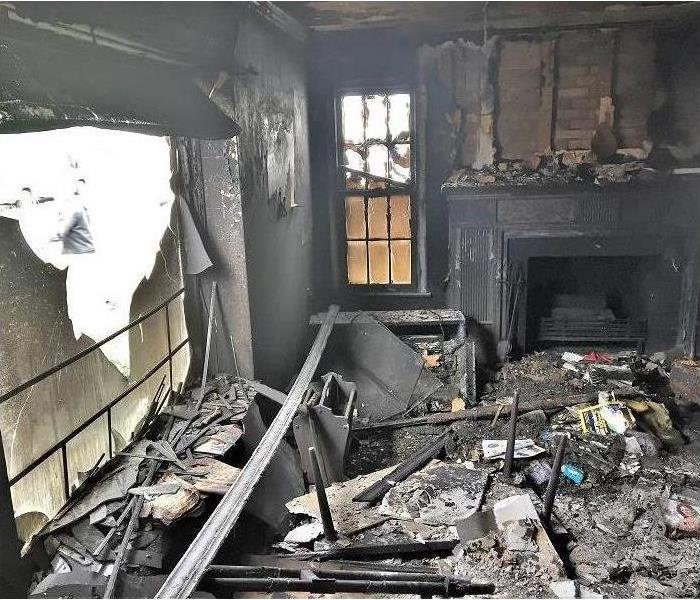 Our team cleaned up this Green Bay area home after a severe fire.
Our team cleaned up this Green Bay area home after a severe fire.
Smoke and soot is very invasive and can penetrate various cavities within your home, causing hidden damage and odor. Our smoke damage expertise and experience allows us to inspect and accurately assess the extent of the damage to develop a comprehensive plan of action.
Smoke and soot facts:
- Hot smoke migrates to cooler areas and upper levels of a structure.
- Smoke flows around plumbing systems, seeping through the holes used by pipes to go from floor to floor.
- The type of smoke may greatly affect the restoration process.
Different Types of Smoke
There are two different types of smoke–wet and dry. As a result, there are different types of soot residue after a fire. Before restoration begins, SERVPRO of West Brown County will test the soot to determine which type of smoke damage occurred. The cleaning procedures will then be based on the information identified during pretesting. Here is some additional information:
Wet Smoke – Plastic and Rubber
- Low heat, smoldering, pungent odor, sticky, smeary. Smoke webs are more difficult to clean.
Dry Smoke – Paper and Wood
- Fast burning, high temperatures, heat rises therefore smoke rises.
Protein Fire Residue – Produced by evaporation of material rather than from a fire
- Virtually invisible, discolors paints and varnishes, extreme pungent odor.
Our Fire Damage Restoration Services
Since each smoke and fire damage situation is a little different, each one requires a unique solution tailored for the specific conditions. We have the equipment, expertise, and experience to restore your fire and smoke damage. We will also treat your family with empathy and respect and your property with care.
Have Questions about Fire, Smoke, or Soot Damage?
Call Us Today – 920-434-8224.
Project Profile: Garage Fire
2/5/2019 (Permalink)
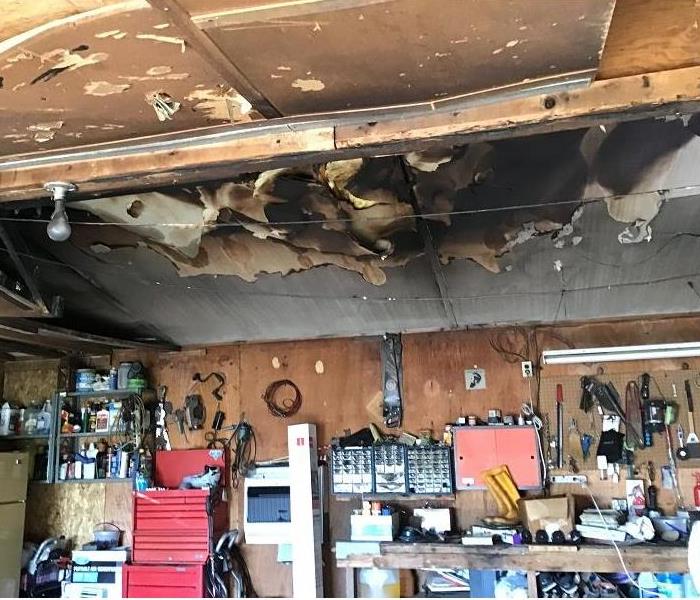 Photo of garage fire.
Photo of garage fire.
A garage fire can be a devastating event. Flames can start fast, tearing through the garage itself and then, if it’s an attached garage, move just as quickly into and through the home. And even when the blaze keeps to the garage, soot and smoke damage can get into the house.
SERVPRO of West Brown County recently cleaned up after a garage fire in the Green Bay area. Luckily, in this case, the flames stayed contained to the garage.
The flames did cause severe damage in the garage. Pictures show soot and smoke damage left behind on just about every, single inch of the building. The damage was not limited to the structure itself, but also affected items stored in the garage like tools.
To start the cleanup, our technicians removed all the contents, threw away anything damaged beyond repair (after getting the client’s consent). Techs also photographed any non-salvageable items to ensure full documentation for the insurance company.
The crew then worked quickly to tear out and remove any severely damaged structural elements like drywall and insulation. Then the techs were able to clean the smoke and soot off the walls, ceilings and floors.
The team also took the damaged contents back to our shop to clean them individually, returning those salvageable items back to the property owners after cleaning.
At the end of cleaning we deodorized and ozoned the area to counteract smoke molecules and dissipate them to eliminate any remaining odor.
In this case it took us a couple of days to make the garage fire, “Like it never even happened.”
And if the blaze had been bigger, getting into the home, we would have been able to clean that up as well, taking care of any soot and smoke odors left behind too.
Our team works quickly, carefully and efficiently to clean up and restore any property damaged by a disaster.
If you need our help, call us 24 hours a day, seven days a week at 920-434-8224.
Holiday Prep Profile: Christmas Trees
11/27/2018 (Permalink)
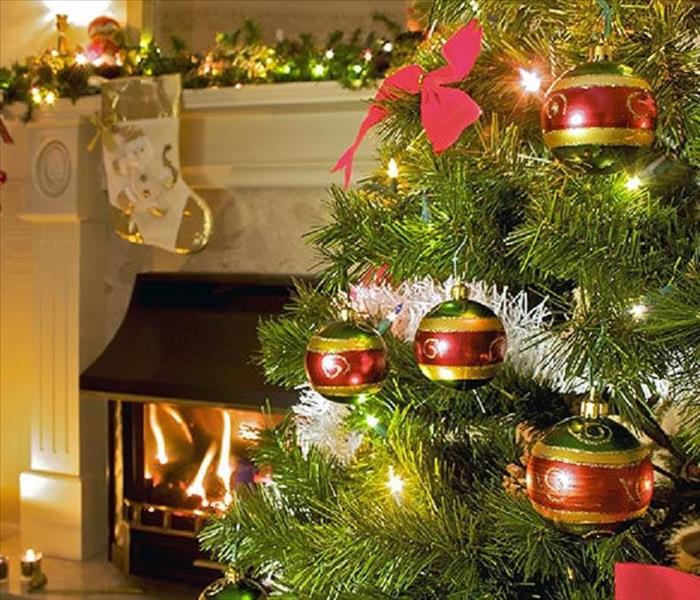 Photo of a decorated tree courtesy of the American Christmas Tree Association.
Photo of a decorated tree courtesy of the American Christmas Tree Association.
As we reflect on our Thanksgiving and look forward to the rest of the holiday season, for many of us, this time of year would not be the same without a Christmas tree.
It’s likely you’ve already started to see lots full of trees popping up all over town, maybe noticing the well-lit evergreens appearing in your neighbors’ windows, or, possibly, you’ve even set up your own tree! These festive firs bring back fond memories for many of Christmases past.
And while the tree if often the centerpiece of the Christmas decorations in many homes, the holiday symbol does come with dangers. We do hate always being the bearers of bad news here, but according to the National Fire Protection Association (NFPA), Christmas trees are responsible for about 210 home fires each year in the United States, leaving behind about $13 million in damage.
So, what can you do to ensure your Christmas tree is safe for the season?
First, the NFPA, advises using a modern, artificial tree from a reputable company. These artificial trees are less likely than live trees to start a fire (although you should still make sure to use proper lights on artificial trees and to turn off the lights when you go to bed or leave your home).
However, if you cannot imagine an artificial tree in your home and a real, live tree is the only one for you, there are precautions you can take to lessen your fire risk. The NFPA advises the following:
- Choose a very fresh, green tree with needles that do not fall off when touched.
- Make sure the tree is at least three feet from any heat source like fireplaces, candles or heat vents.
- Make sure to water the tree daily.
- Make sure the tree is not blocking any exits.
- Use only lights from reputable companies that have been independently tested.
- Replace any lights with damaged bulbs or cords.
- NEVER use lit candles to decorate the tree.
- Do not overload electrical outlets.
- Turn off lights when you go to bed or leave the house.
- Get rid of the tree after Christmas, or as soon as it starts to lose its needles.
Please keep these safety measures in mind as you get into the holiday spirit this year.
Enjoy the holidays, be safe and, remember, you can call us any day of the year, at any time of the day at 920-434-8224.
Holiday Prep Profile: Deep Frying a Turkey
11/13/2018 (Permalink)
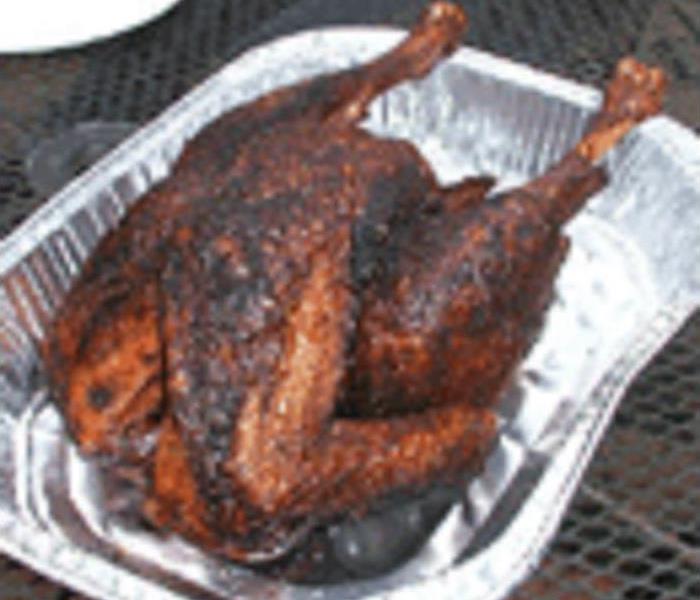 Turkey photo courtesy of NFPA.
Turkey photo courtesy of NFPA.
We’re less than a week away from one of the most delicious holidays of the year. That’s right, Thanksgiving is almost upon us.
Most people who plan to host family and friends this year already have a plan in place for what they’re going to cook: what sides they’ll make, what dessert they’ll serve and how they’ll prepare the main dish, the turkey.
And while most home chefs will probably put old Tom Turkey in the oven for the traditional roasting, some cooks will likely try something more adventurous: deep frying.
Deep frying a turkey can certainly create something delicious, but it is one of the most dangerous activities of the holiday.
According to the U.S. Fire Administration, there are five major concerns when it comes to turkey frying:
- Turkey fryers can easily tip over spilling hot cooking oil over a large area.
- An overfilled cooking pot will cause cooking oil to spill when the turkey is put in, and a frozen turkey will cause cooking oil to splatter when you put it in the pot.
- Even a small amount of cooking oil spilling on a hot burner can cause a large fire.
- Without thermostat controls, deep fryers can overheat oil to the point of starting a fire.
- The sides of the cooking pot, lid and pot handles can get dangerously hot.
So, if you’re planning to try out deep frying a turkey this year, you need to be prepared and take serious precautions to avoid any of those above concerns.
State Farm Insurance Company has a long list of safety steps you should take:
- Keep outdoor fryers off decks, out of garages and away from trees and bushes.
- Make sure the turkey is completely thawed and dry before frying to keep oil from splattering.
- Do NOT operate a fryer outdoors in the rain or snow.
- Place the fryer on a level surface and don’t move it once it’s in use.
- Follower the manufacturer’s directions to avoid overfilling the oil.
- Choose a smaller turkey, between 8 and 10 pounds for frying.
- Never leave fryer unattended.
- Use a fryer with temperature controls. Watch the controls to make sure the oil does not get too hot. If the oil starts smoking, turn off the fryer.
- Turn off the burner before putting the turkey in the fryer. Once the turkey is in the fryer, turn the burner back on.
- Wear goggles and over mitts to protect your eyes and arms.
- Keep an ABC-rated fire extinguisher (one that can be used on grease fires) on hand. Never try to put out a grease fire with water.
- Keep children and pets away from fryers at all times.
- Once finished, carefully remove the pot from the burner. Allow the oil to cool overnight before disposing of it.
Keep in mind that, even if you follow all the safety tips, frying a turkey still comes with risks. In fact, the National Fire Protection Association and State Farm recommend using an oil-less fryer, one that uses infrared heat instead of oil, to fry your turkey. Both organizations say that is the safest option.
Whatever you decide for your Thanksgiving celebration, we wish you a very happy one!
And if you should even need our help with fire damage restoration in the Green Bay area, we’re just a phone call away at 920-434-8224.
Holiday Prep Profile: Fire Extinguishers
11/6/2018 (Permalink)
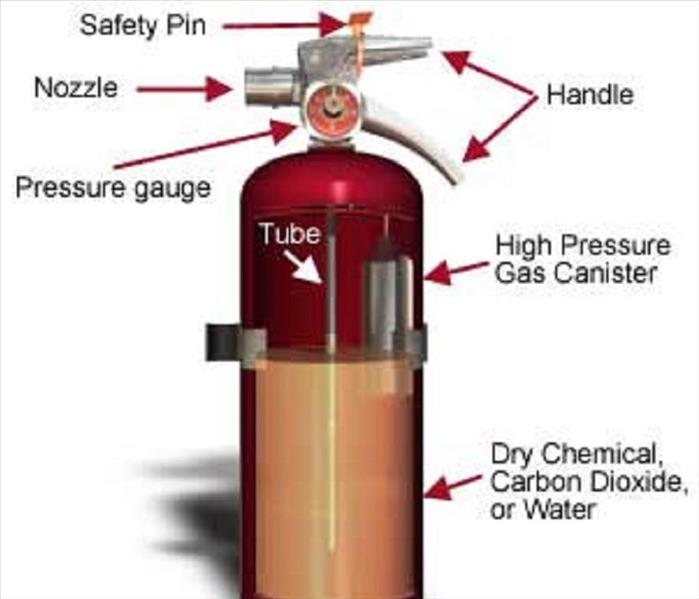 Fire extinguisher photo, courtesy of OSHA.
Fire extinguisher photo, courtesy of OSHA.
It is officially November!
Halloween is behind us, Thanksgiving and Christmas are still ahead, and while it might be too early for some to hear Christmas carols on the radio and in the stores, it’s NEVER to early to do some safety prep for the holiday season.
On Fridays this month we will take a look at some different safety considerations you might want to take before your celebrations begin.
For our first Holiday Prep Profile, we’re going to talk about fire extinguishers.
Why fire extinguishers? Well, according to the National Fire Protection Association, or NFPA (one of our favorite sources, don’tcha know!), cooking fires peak during the holiday season. The NFPA says the most cooking fires occur on Thanksgiving, then Christmas Day, then Christmas Eve. Oh, and cooking fires are the leading cause of home fires.
So, all those statistics are certainly reason enough to consider getting a fire extinguisher for your home before the holidays AND learn how to use it properly.
First and foremost, you’re going to want to choose the right fire extinguisher. There are several classes of them, which the NFPA describes:
- Class A – this is the most common extinguisher and can be used to put out fires on cloth, wood, rubber, paper and many plastics.
- Class B – this is used on fires involving flammable liquids like gasoline, grease and oil.
- Class C – this is used for fires that involved electrical appliances and tools that are plugged in.
- Class D – this is used on flammable metals and is typically only found in factories that work with those metals.
- Class K – this is used on fires that involve oils and animal fats INSIDE cooking appliances. These are typically only found in commercial kitchens; however, they are on the market for use in homes.
The NFPA advises choosing a fire extinguisher for your home that is multi-purpose and large enough to put out a small fire, but not so large that it is difficult to handle.
The association also recommends reading all of the fire extinguisher’s directions and becoming familiar with it as soon as you buy it. This way you’ll know how to use it if you need it.
And when it comes to using it, remember the acronym PASS:
- P – Pull the pin. Hold the nozzle away from you and release the locking mechanism.
- A – Aim Low. Point the extinguisher at the base of the fire.
- S – Squeeze. Squeeze the lever slowly and evenly.
- S – Sweep. Sweep the nozzle from side-to-side.
The NFPA WARNS a fire extinguisher should ONLY be used if the fire is contained to a SMALL area, is NOT growing and the room is NOT filled with smoke. Otherwise, it is far too dangerous to try to put out a fire using an extinguisher and you should leave the home immediately. And, the NFPA says, you should always call the fire department.
A fire extinguisher is certainly a good tool to have in your home, particularly around the holiday season. However, it is not the be-all or end-all for fire safety. Take care of yourself and always put your safety first.
Fire Prevention Profile: What to Do Until Help Arrives
10/31/2018 (Permalink)
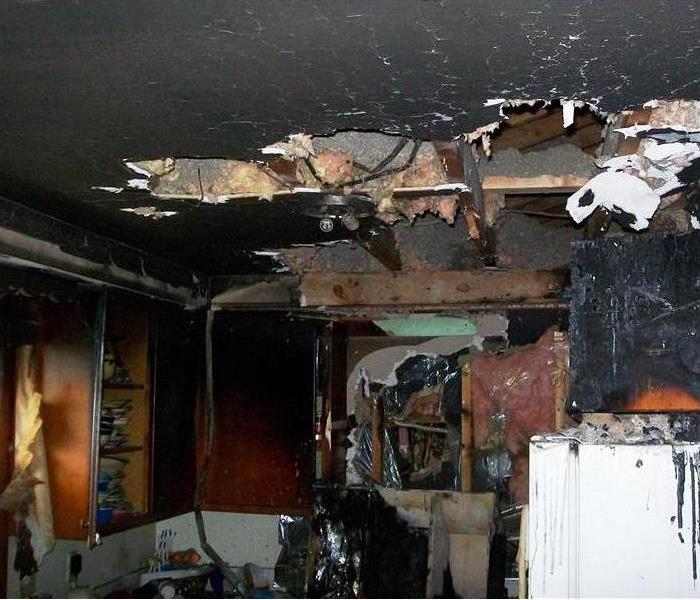 Damage from a fire in the Green Bay area.
Damage from a fire in the Green Bay area.
October has come to an end and, with it, so has Fire Prevention Month. However, you are in luck, as we have one more, bonus prevention profile to share! (And, let’s be honest, it’s never a bad time to talk about fire prevention.)
Aside from the obvious dangers house fires present, even the smallest blazes can bring big headaches. Meaning, even fires that are put out quickly without injury can leave soot, smoke damage and other nasty problems.
That’s where SERVPRO of West Brown County comes into the picture. After the you or firefighters have done the heavy lifting of putting out the flames, our technicians come in to clean up the damage left behind. We have the expertise and equipment to make a fire “like it never even happened.”
There are some things you can do to make that recovery process go smoothly and ensure the damage doesn’t get any worse before our team arrives.
SERVPRO advises these DOs:
- Limit movement in the home to prevent soot particles from being embedded into upholstery and carpet.
- Keep hands clean. Soot on hands can cause further damage to upholstery, walls and woodwork.
- Place dry, colorfast towels or old linens on rugs, upholstery and carpeting.
- Wipe soot from chrome kitchen/bathroom faucets, trim and appliances. Then protect these surfaces with a light coating of lubricant.
- If heat is off during winter, pour RV antifreeze in sinks, toilet bowls, holding tanks and tubs to avoid freezing pipes and fixtures.
- Change HVAC filters; leave system off until a trained professional can check the system.
- Tape double layers of cheesecloth over air registers to stop soot particles from getting in or out of the HVAC system.
And along with those DOs, there are a list of DON’Ts:
- Don’t attempt to wash any walls or painted surfaces without first contacting your SERVPRO professionals.
- Don’t attempt to shampoo carpet or upholstery without first contacting your SERVPRO professionals.
- Do not attempt to clean nay electrical appliances that may have been close to fire, heat or water without first contacting an authorized repair service.
- Do not consume any food or beverages that may have been stored close to fire, heat or water, as they may be contaminated.
- If ceiling is wet, do not turn on any ceiling fans. Wiring may be wet or damaged and cause electrical shock, and air movement may cause secondary damage.
- Don’t send garments to dry cleaner. Improper cleaning may set in odor smoke.
Hopefully you never need this advice, but if you do, the steps are simple ones to take to ensure your property can be restored as easily as possible.
At SERVPRO of West Brown County we know a fire of any size can be a traumatic event and we know the damage left behind, the sights and smells of soot and smoke, can amplify and prolong that trauma. It is our goal to take care of that damage quickly and efficiently to help minimize the trauma and get your life back in order.
We are always just a phone call away at 920-434-8224.
Fire Prevention Profile: Home Heating Safety
10/25/2018 (Permalink)
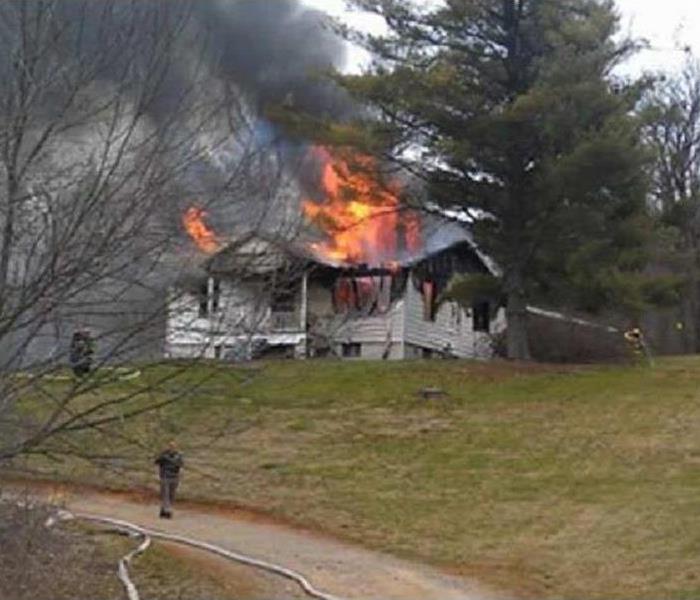 House fire photo, courtesy of FEMA.
House fire photo, courtesy of FEMA.
As October comes to an end, we can all start to feel that chill in the air.
Fall is a time known for “sweater weather,” a time of year to get cozy. And as we get deeper into autumn, we know old man winter is not far behind.
When winter arrives, the sweaters are no longer enough to keep us warm and snug and we all start to rely on home heating to get us through the bitter months (honestly, some of us have already turned on our thermostats!).
However, when it comes to home heating, the threat of fire is never far behind. In fact, according to FEMA, heating is the second leading cause of home fires after cooking.
Furnaces, space heaters, fireplaces and woodstoves all have the potential to cause a blaze. So, it’s important to follow some safety rules when using any of these.
FEMA has a list of advice for each piece of equipment we listed:
- Furnaces:
- Have your furnace inspected each year by an HVAC professional.
- Keep anything flammable at least three feet from your furnace.
- Keep anything flammable away from implements like heat registers too.
- Woodstoves/Fireplaces:
- Have your chimney inspected and cleaned once a year.
- Keep anything that can burn at least three feet from your fireplace or woodstove.
- Do not burn paper in your fireplace or woodstove.
- Put the fire out before you go to sleep or leave the house.
- Put ashes in a metal container with a lid, outside, at least three feet away from your house.
- Keep a glass or metal screen in front of your fireplace to keep sparks and embers from jumping out.
- Space Heaters:
- Again, keep anything flammable or that can burn, at least three feet away from the space heater.
- Make sure the heater has an automatic shut off on the event it falls over.
- Turn heaters off when you leave the room or go to bed.
- Plug portable heaters directly into wall outlets, never into extension cords or power strips.
- Only use space heaters from a recognized testing laboratory.
These are some easy tips to follow and they’re also very important. According to FEMA, 75% of home heating fires are “confined,” meaning they are confined to chimneys, flues or fuel burners (so get those chimneys cleaned!) and 29% of heating fires that are not confined are caused when something flammable is left too close to a heat source.
It’s also important to note that, as FEMA reports, home heating fires peak in January (that’s the month when 21% of those blazes occur) and those fires peak between the hours of 5:00 and 9:00 p.m.
So, be sure to stay warm and cozy and SAFE during the cold months ahead!
Fire Prevention Profile: Electrical Fires
10/18/2018 (Permalink)
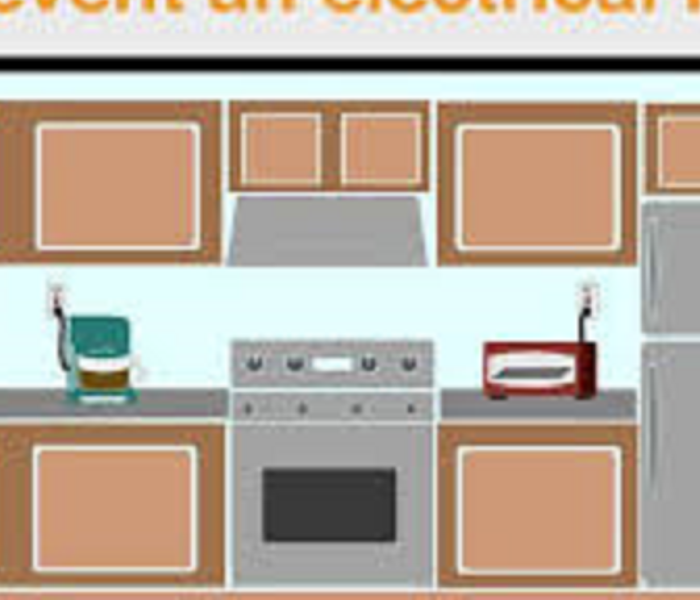 Picture courtesy of FEMA.
Picture courtesy of FEMA.
As the days grow shorter and the nights grow longer, we all start to rely more heavily on our lights and other electronic devices to keep our homes bright and warm. But, along with the increased use of electricity comes a greater risk of electrical fires.
And since October is fire prevention month, now is a great time to ensure your home is safe from this risk before we get into the bitter winter months.
According to FEMA there are more than 45,000 home electrical fires each year in the United States. Half of those are caused by lighting equipment or home electrical wiring. FEMA says the peak months for these fires are December through March and deaths caused by these blazes peak between the hours of midnight and 6:00 in the morning (a very good reason to have working smoke detectors in your home!).
There are some very easy steps you can take immediately to prevent electrical fires. FEMA has an easy to follow checklist for you:
- Always plug appliances (especially major appliances like washers, dryers and refrigerators) directly into wall outlets.
- Never use an extension cord with those major appliances, as the cords can overheat quickly and cause a fire.
- Unplug small appliances when not in use.
- Plug only one heat-producing appliance (like a coffee maker or microwave) into an outlet at a time.
- Never use an extension cord with a heat-producing appliance.
- Keep light fixtures and lightbulbs away from anything flammable.
- Use lightbulbs that match the recommended wattage of the light fixture.
- Check the cords on appliances often. Replace any cracked, damaged or loose cords.
- Do not overload wall outlets.
- Insert plugs fully into sockets.
- Never force a three-prong plug into a two-prong outlet.
- If you have young children, be sure to install tamper resistant outlets.
- Replace old, worn or damaged extension cords right away.
- Use extension cords for temporary purposes only.
- Avoid putting cords where they can be damaged or pinched (like in heavy traffic areas where they might be stepped on).
- Do not overload power strips.
- Only use power strips with internal overload protection.
Now that you have this list, we recommend you go through your home and check off every bullet point on there (What are you waiting for? Do it now!). Doing so can help protect you, your family and your property, while keeping things bright this winter.
Fire Prevention Profile: Kitchen Fires
10/10/2018 (Permalink)
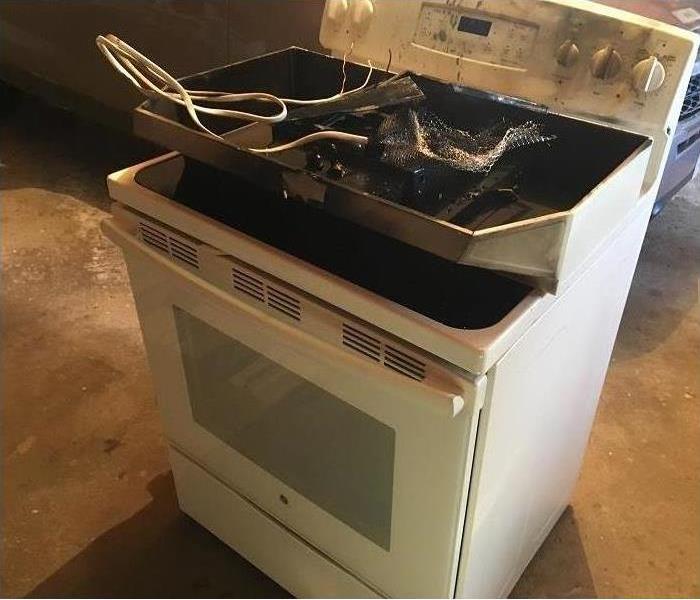 A stove that caught fire in the Green Bay area
A stove that caught fire in the Green Bay area
Cooking fires are the number one cause of home fires in the United States and the dangers only rise as we get into the holiday season. So, (since October is Fire Prevention Month) now is a good time to learn more about these incidents and what you can do to prevent them.
The statistics when it comes to kitchen fires are stark. According to the National Fire Protection Association (NFPA), cooking accounts for about 47% of home fires, 20% of fire-related deaths and 45% of the fire-related injuries reported across the country each year. The NFPA says Thanksgiving is the peak day for home cooking fires, followed by Christmas Day and then Christmas Eve.
Luckily, there are many simple steps home chefs can take to avoid these fires. One big step? Always watch what you’re cooking. The NFPA tells us one third of kitchen fires happen when a person leaves the equipment they’re using unattended. So, particularly if you’re using the stove top, stay in the kitchen and watch closely. If you’re using the oven, experts advise checking in regularly.
It’s important to remember, kitchen fires don’t just happen when food burns, anything flammable can catch fire if it’s too close to the heat. So, keep anything like oven mitts, dish cloths and paper towels AWAY from heat sources.
We have saved the BIGGEST culprit of cooking fires for last: frying. The NFPA says frying dominates the cooking fire problem. So, the Association has some advice you’ll want to follow this holiday season (and, of course, all year long):
- Always stay in the kitchen when frying.
- If you see smoke coming off the food you’re frying, turn off the burner or safely remove the pan from the burner. Smoke it a sign the oil is too hot.
- Slowly heat the oil to the temperature you need.
- Add food to the oil gently so that it does not splatter.
- Always keep a lid beside your pan. If the pan does catch fire, cover it with the lid and turn off the banner. Let the oil cool before removing the lid again.
- NEVER put water on a grease fire. If a fire starts to spread, leave the house immediately and call 911.
Now you know a little bit more about how to stand the heat and stay in the kitchen SAFELY. Team SERVPRO of West Brown County wishes everyone in the Green Bay area and beyond a very safe and happy holiday season!
Fire Prevention Profile: October is Fire Prevention Month
10/4/2018 (Permalink)
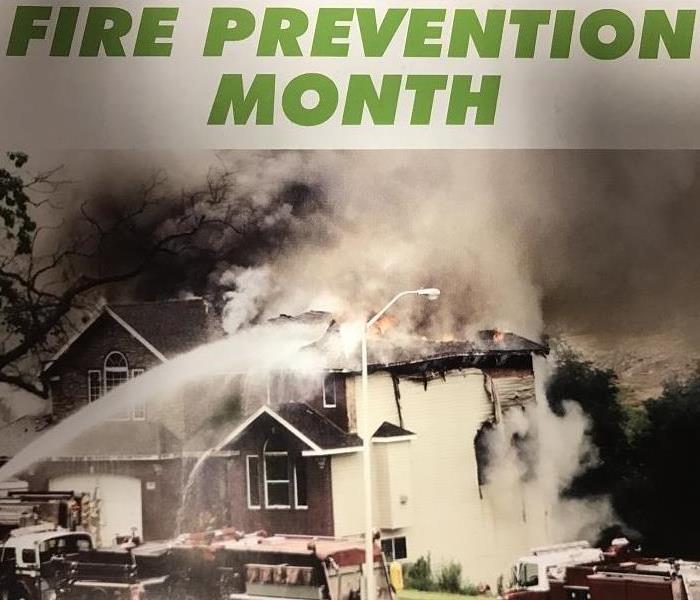 October is Fire Prevention Month
October is Fire Prevention Month
October is National Fire Prevention Month and we at SERVPRO of West Brown County want to ensure you are staying safe this month and all year long.
And in that spirit, we will be posting Fire Prevention Profiles each Friday in October.
For this first profile, we will provide some general prevention tips. The second week we will talk about preventing kitchen fires, the third week we’ll cover electrical fire prevention and the final fire prevention profile will discuss home heating safety and how that relates to fire prevention.
So, diving in to this week, the National Fire Protection Association, or NFPA, provides a theme each year for fire prevention and 2018’s theme is “Look. Listen. Learn. Be Aware. Fire can happen anywhere.”
So here is what the NFPA advises:
- LOOK – look for places in your home fires could start. Identify any possible hazards and take care of them.
- LISTEN – listen for the sound of your smoke alarm. If you hear the smoke alarm, leave the building immediately. You only have minutes, sometimes seconds to escape the smoke and flames safely once you hear the alarm.
- LEARN – learn (and teach your family) two ways out of every room and make sure all doors and windows leading outside open easily and are free of clutter.
This is also a great time of year to PREPARE for emergencies! In case you didn’t see our Preparedness Profiles from last month, they are all still in our blog archives, which you can find easily on our website and our social media pages. You can find out more about preparing for evacuations, pet safety in emergencies and proper use of smoke and carbon monoxide detectors.
And always remember, if a fire should damage your home or business, SERVPRO of West Brown County is always here for you. You can reach us, day or night, at 920-434-8224.
What's that Smell? Talking Odor Removal
7/24/2018 (Permalink)
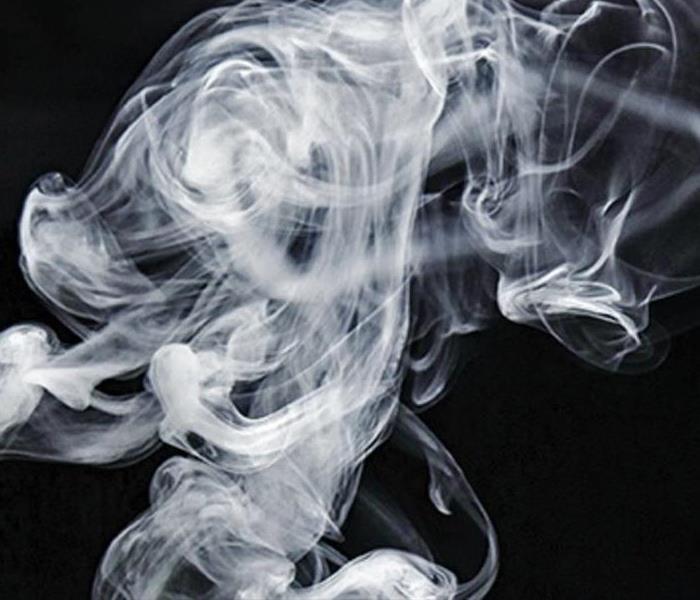 Photo of Smoke courtesy of the NFPA
Photo of Smoke courtesy of the NFPA
While a fire can happen in the blink of an eye, the damage it leaves behind can go on for ages.
This is true when it comes to the severe, physical damage flames cause. It’s also true when it comes to something unseen, but no less tangible: the smell. Odors from smoke can and will linger for years, especially if they’re not dealt with quickly.
Smoke, soot and ash are made up of tiny particles that move around easily and get into hard-to-reach nooks and crannies. Those little particles are very clingy and stick to surfaces of all kinds, the more porous the better.
The good new is, SERVPRO of West Brown County can destroy those odors left behind by a fire.
And when we say “destroy,” we mean it.
Many people think that getting rid of bad smells simply means covering them up with some sort of perfumed product. That will NOT do the trick. The odors must be completely eradicated.
That’s where trained SERVPRO technicians come into the picture. They will seek out and remove the SOURCES of the smells. The techs are trained to remove those sources using deodorization techniques and equipment like ozone machines and hot thermal fog.
We understand that fires are traumatic events that can have a long-lasting effect on a person’s emotional and mental state. Having the smell around only serves as a reminder of what happened and can make that trauma even worse for a person.
We’re here to help you make things better.
And we can help you in other situations where unpleasant smells are making your home or office miserable.
These are just a few of the other odors we can clean up:
- Cigarette Smoke
- Pet Odors
- Decomposition
- Mold
If you need to breathe a little easier, we’re here to help clear the air. Give us a call at 920-434-8224.
Fireworks: Play it Safe this 4th of July
7/3/2018 (Permalink)
 Fireworks photo from the CDC
Fireworks photo from the CDC
As we celebrate our country’s birth and Independence Day, we know a lot of fun comes with that celebration. However, sometimes that fun comes with dangers.
We’re talking about fireworks. The explosions in the sky are synonymous with the 4th of July, but, if not used properly, they can cause fires and severe injuries.
The best advice to remember is that fire officials, both locally and nationally, advise you leave any exploding fireworks displays to the professionals. They say you should go see your local community’s fireworks show and enjoy it!
When it comes to trying out your own, personal pyrotechnics, however, there’s a lot more you need to know.
First of all, fireworks that leave the ground and/or explode may not be legal, depending on the community you live in. You must check in with your local municipality to see what is or is not legal, or else face punishments like heavy fines.
When it comes to the fireworks that ARE legal, if you want to put on your own show, the National Council on Fireworks Safety has a list of reminders for you to avoid any mishaps:
- Read all cautionary labels before lighting fireworks.
- A responsible adult should supervise all activities.
- Do NOT drink alcohol while using fireworks.
- Light one firework at a time and walk away from it.
- Use fireworks outdoors in an area clear of buildings and trees.
- Always have a water source nearby.
- Never relight a “dud.”
- Soak any used or dud fireworks in water and throw them away in a metal trash can.
- Remember, even sparklers get EXTREMELY hot.
- Veterans groups ask that you consider your neighbors. If you know your neighbor is a combat veteran, check with them before putting on any pyrotechnics.
According to the U.S. Consumer Products Safety Commission, an average of 280 people go to the emergency room with fireworks-related injuries each 4th of July. Of those injuries, 53% are burns and 14% come from sparklers. The commission says the age group reporting the most injuries includes people between the ages of 25-44-years-old.
Fire officials say it’s important to remember your pets this time of year too. According to the Wisconsin Humane Society, more pets are lost on July 4th than any other day of the year. Experts say this is because pets can become frightened by the loud noise of fireworks and run off. They advise keeping your pets inside and safe during any displays.
And if something should go awry because of fireworks this holiday, remember, SERVPRO of West Brown County is here for you to help recover from any fire damage. You can call us at 920-434-8224.
Fire Safety for Four-Legged Family Members
6/13/2018 (Permalink)
 Boo, the SERVPRO of West Brown County office dog
Boo, the SERVPRO of West Brown County office dog
We at SERVPRO of West Brown County consider our pets to be part of our families. We suspect most pet owners feel the same way. So, it’s important to consider your four-legged friends when planning for emergency situations. Top among those emergencies are house fires.
According to the United States Fire Administration, about 500,000 pets are affected by fires each year.
The Red Cross says the easiest and most important way you can protect your pets is by including them in your fire plans. That means practicing your escape routes with your pets and training them to come when you call.
As important as our furry friends are, however, you should NEVER waste time during a fire to go looking for your pets. Do NOT put your life or your families lives at risk.
Luckily, there is more you can do to ensure your pets’ safety. You can help firefighters find them by putting a pet alert cling in your front window with the accurate number and types of pets you have written on it. Your local fire department likely has these clings available.
You can also make sure to keep any crated pets close to the door to help firefighters find them right away. In addition, keeping leashes or carriers near the door can help too.
Aside from planning for your pets, the Red Cross says you should also make sure to keep your four-legged friends from STARTING fires.
According to the National Fire Protection Association, about 1,000 pets are responsible for starting house fires each year.
The Red Cross recommends you follow these steps to help prevent a similar situation in your home:
- Keep pets away from open flames like candles or fireplaces. Cats and dog tails can easily knock over lit candles.
- Invest in flameless candles or air fresheners.
- Take knobs off the stove when you’re out of the home.
- Block pets, particularly young pets, from any possible fire-starting materials with crates or baby gates.
We know how much you love your pets. So never underestimate how important it is to make family plans for emergencies and include the furballs in those plans.
And should fire damage ever strike your home, we are here to help you recover. You can call us, day or night, at 920-434-8224.
Clean Your Dryer Vents!
5/10/2018 (Permalink)
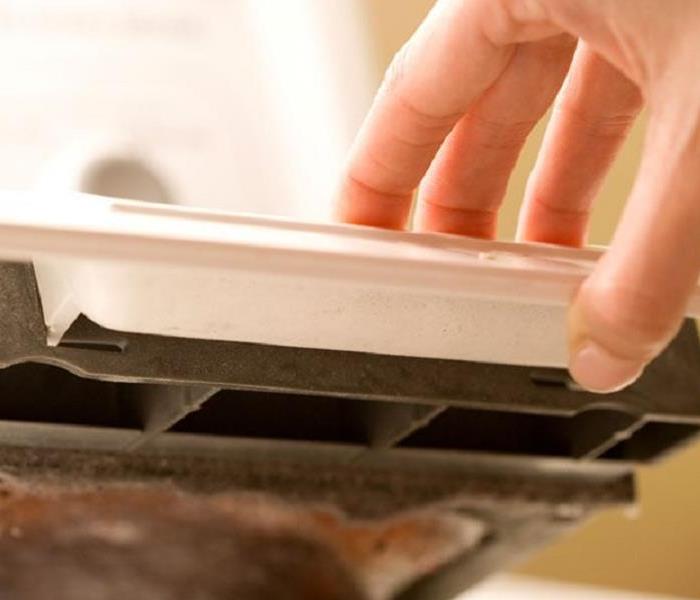 Photo of a dryer lint filter courtesy of FEMA.
Photo of a dryer lint filter courtesy of FEMA.
A clothes dryer is one of those household conveniences most of us can’t imagine living without. But, if you’re not taking a few simple steps to ensure your dryer is safer, the machine could become a veritable tinder box.
Dryer lint is extremely flammable and if you’re not keeping your dryer clean and well-ventilated, you’re putting your home and yourself at risk.
According to FEMA 2,900 home dryer fires are reported yearly. Those fires cause an estimated 5 deaths, 100 injuries and $35 million in property damage each year.
FEMA says 34% of those fires are caused by failure to properly clean the dryer.
Luckily there are a few simple steps you can take to prevent dryer fires.
FEMA advises:
- Have the dryer installed by a professional in the first place.
- Clean the lint filter before and after each load of laundry and in between cycles, if it needs to run more than once.
- Clean the back of the dryer where lint can build up.
- Clean lint out of the vent pipe once every three months.
- If it’s taking longer than normal for clothes to dry, have a professional inspect it.
- Ensure the venting system behind the dryer is connected and un-damaged.
- Check regularly to make sure things like animal nests are not blocking the outside vent.
- Keep anything flammable away from the dryer.
- Do not leave the dryer running when you leave home or go to bed.
Something as small as a little bit of lint can be easy to overlook, but it can also have big consequences if you do.
So please keep your dryer clean and your home safe!
And should you experience a fire of any kind, remember, we are here to help with cleaning, recovery and reconstruction. Simply give SERVPRO of West Brown County a call at 920-434-8224.
Wildfires: Watches and Warnings
5/1/2018 (Permalink)
 National Weather Service photo of a wildfire
National Weather Service photo of a wildfire
In our last blog post we discussed wildfires. We took a look at how you can help prevent wildfires and how you can protect your property against them.
Now let’s take a look at what you need to know when it comes to the National Weather Service’s (NWS) Watches and warnings for wildfires. Do you know the difference between a red flag warning and a fire weather watch? If not, it’s an important distinction.
Let us break it down for you:
- Fire Weather Watch: According to the NWS, a Fire Weather Watch is when you need to PREPARE, because weather conditions over the next 12 to 48 hours are expected to create a critical risk for wildfires.
- Red Flag Warning: According to the NWS, a Red Flag Warning is when you need to TAKE ACTION, because this is the alert that is sent out when fire conditions are ongoing or are expected to occur within the next 24 hours.
- Extreme Fire Behavior: This is the alert the NWS will put out when an already ongoing wildfire is likely to rage out of control. To send out this alert, one of the following conditions must be met:
- The fire is moving fast.
- There is prolific crowning, meaning the tree canopy is catching on fire, or spotting, which means embers from the main fire are blowing to new areas, starting new fires.
- Presence of fire whirls, which are like tornadoes of flame.
- A strong convection column, which is a column of gases, smoke and ash that is rising out of the wildfire.
Don’t forget, the Wisconsin DNR is another resource you can turn to in order to find out more about the risk of wildfires in your area and how you can work to keep yourself safe.
And if a wildfire leaves its mark on your property, SERVPRO of West Brown County is here to help you recover and rebuild from any flame, smoke or soot damage. Just give us a call at 920-434-8224.
Wildfire Awareness
4/26/2018 (Permalink)
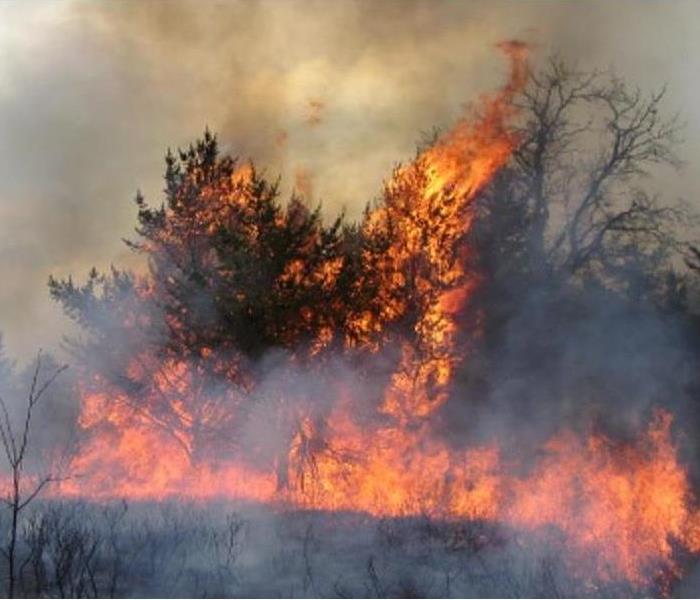 Photo of a wildfire from the Wisconsin DNR
Photo of a wildfire from the Wisconsin DNR
As Smokey Bear says, ‘only you can prevent wildfires.’
And, according to the Wisconsin DNR, spring is the riskiest time of year for wildfires across the state. Summer is a close second in that department.
The DNR says spring is especially dangerous once the snow melts, because even a few days without rain can lead to dry grasses, pine needles, and leaves. Combine those dry fuels with lower humidity, warmer temperatures and blustery winds and you have conditions that can easily create fast moving wildfires.
What Smokey says is certainly true too, because, according to the DNR, 98% of wildfires in Wisconsin are caused by people.
Here are some of the most common causes:
- Burning debris
- Using equipment and vehicles like lawnmowers and ATVs
- Campfires
- Fireworks
- Railroads
- Smoking
- Power lines
- Arson
There are some precautions you, personally, can take to prevent these fires:
- Have water on hand any time you burn or build a campfire.
- Fully put out a burn or campfire by drowning it with water, stirring it, drowning it again and feeling the area with the back of your hand to ensure it’s no longer warm. If it is warm, drown and stir it again!
- Do not use equipment like lawnmowers on especially dry days as they can spark, leading to fires.
- If you see smoke along the railroad tracks, call 911 and report it.
- Do not throw lit cigarettes away outside.
Now, depending on where you live and play, your home or other property could be at risk from wildfires. The DNR says your property is especially vulnerable if it’s in a rural or wooded area surrounded by tall grasses or trees like pines and oaks.
The National Fire Protection Association has named May 5th, 2018 Wildfire Community Preparedness Day. So, now is a good time to know the risk at your own property and take some precautions.
The DNR recommends:
- Rake leaves away from your house and from under your deck.
- Remove leaves and pine needles from your gutters.
- Clear a five-foot zone around your building of any flammable materials.
- Move firewood at least 30 feet from your home.
If you see a Smokey Bear sign in your community, take note of what it says. If Smokey says there’s a risk for fire danger, believe him and take precautions.
And if a wildfire should ever affect your Green Bay area property, SERVPRO of West Brown County is always here for you. We can help clean, restore and rebuild following any damage. Just pick up the phone and call us any time, day or night at 920-434-8224.
What You Need to Know: Generator Safety
4/18/2018 (Permalink)
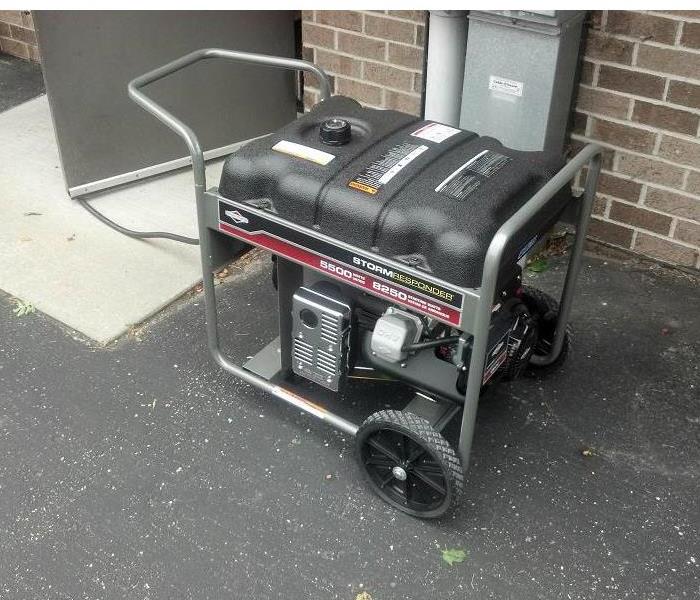 Photo of a generator from the Wisconsin Red Cross.
Photo of a generator from the Wisconsin Red Cross.
As we’ve been writing recently about severe weather season and preparing for any possible flooding or storms, we thought it might be a good idea to tackle generators.
Generators are always great to have as a backup if your home or business loses power during a storm, but they can pose serious dangers if you’re not careful.
According to the American Red Cross the biggest dangers generators can pose are fires, electrocution and carbon monoxide (CO) poisoning.
The Red Cross has a long list of safety measures to take if you need to use a generator personally.
- Turn the generator off and let it cool before refueling. Hot fuel can spark a fire.
- Keep the generator dry. Do not use in wet conditions.
- NEVER plug a generator into a wall outlet. That puts you and your neighbors at risk of electrocution.
- Read instructions thoroughly to avoid overloading the generator. Also, stagger use to avoid overloads. Overloads can lead to over-heating, which can lead to fires.
- NEVER use a generator inside your home or inside ANY partially enclosed space.
- Don’t put your generator close to windows or vents to avoid letting CO inside your home.
- Put CO detectors up in your home.
- If the CO alarm goes off, leave the building, go outside into fresh air and call 911 for help. Stay outside until help arrives.
Hopefully you won’t need the help of a generator this spring or summer, but if you do, please remember this advice.
And, also remember that if you do experience any fire, storm or water damage issues, West Brown County. Call anytime at 920-434-8224.
Spring into the Season Safely
4/14/2018 (Permalink)
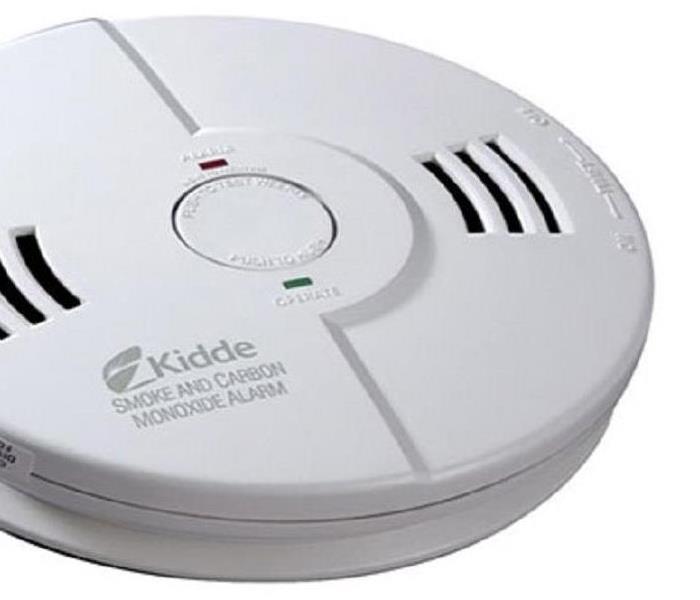 A photo of a smoke alarm from the CDC.
A photo of a smoke alarm from the CDC.
At SERVPRO of West Brown County we know fires can strike at any time of the day or night. We also know how devastating, even deadly those fires can be.
One great way to protect yourself and your family is to make sure you have working smoke alarms in your home. The key word here is WORKING.
The National Safety Council (NSC) has a spring safety checklist for you to check off when doing your annual spring cleaning. Number one on the list? Check those smoke alarms.
The National Fire Protection Association (NFPA) goes a step further saying smoke alarms SAVE LIVES.
An NFPA study shows:
- A smoke alarm sounds in about half of U.S. home fires on average.
- Three of every five home fire deaths occur in houses where there are no smoke alarms, or no working smoke alarms.
- About 70% of the incidents in which the alarms do NOT sound the batteries are missing, disconnected or dead.
There are simple steps you can and should take this spring to make sure your smoke alarms are ready to go. The NSC advises:
- Test your alarms at least once a month.
- Change you alarm batteries at least once a year.
- If an alarm is making a chirping sound, replace the battery immediately.
- Put alarms up in each bedroom and common room on each floor of your home.
Going hand in hand with smoke alarms are carbon monoxide detectors. The NSC describes carbon monoxide (CO) as an “invisible, odorless gas, and it can kill you.”
The NSC has advice about protecting yourself from CO gas:
- Anything that burns fuel can produce CO.
- Carbon monoxide detectors should be installed outside each bedroom and on every level of your house.
- You should test the batteries monthly and change them yearly.
As we get deeper into spring it’s a good idea to go through this checklist to ensure your family is as safe as possible when it comes to fire and carbon monoxide.
Please protect yourself and if a fire should affect your property, we are here for you. Our SERVPRO team is well-prepared to clean up and provide any necessary reconstruction services. You can reach us at 920-434-8224.
Major Fire Restoration
3/27/2018 (Permalink)
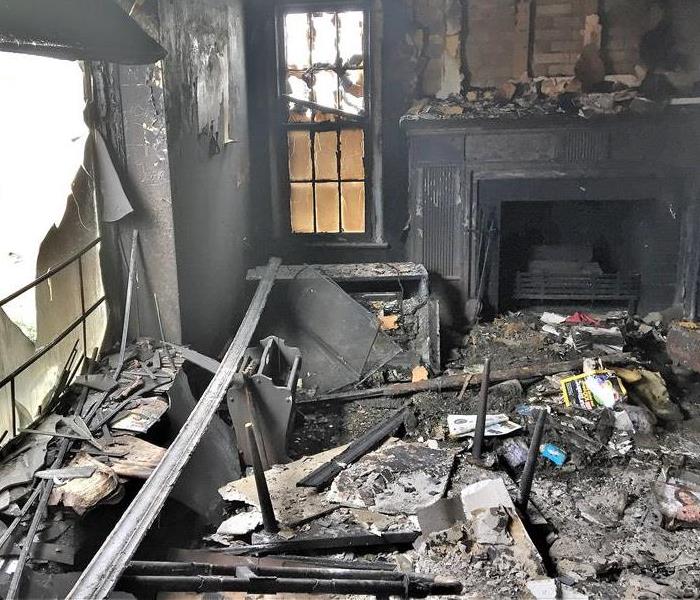 Major fire damage to a home in the Green Bay area.
Major fire damage to a home in the Green Bay area.
A fire can be a devastating event for anyone to experience. The team at SERVPRO of West Brown County understands that and we have seen just how bad that devastation can be.
This photo shows the damage to a home we helped to completely rebuild following a fire in the Green Bay area.
Just about everything was destroyed from the fireplace to the staircase, the dishes in the kitchen to the toilets in the bathrooms. Beautiful antiques were lost in the flames. Ash and soot even reached the parts of the home that were the farthest from the source of the blaze.
Early after the fire happened the homeowner debated whether to have the house demolished or to rebuild instead. They decided to rebuild and called SERVPRO in to do the job.
This was a large-scale residential fire project that required expertise in mitigation, restoration and reconstruction services. The home was completely gutted of all drywall and plaster, flooring materials, cabinetry and all burned or charred structural materials. We also dried out remaining structural components that suffered water damage when the fire department put out the flames with lots of water. Then we replaced the burned and charred structural components, including part of the roof rafters. The electrical and HVAC systems were redone followed by new drywall, paint, flooring, cabinetry, lighting and plumbing fixtures. We even added a new, stone fireplace. On the exterior, we installed new doors, hung new siding and put new shingles in place.
It took team members working tirelessly for several months to complete the restoration. In the end, the home is like brand new
We would never hope for a tragedy like this to affect you and your family, but we do hope if it does, that you’ll call on us to help on the mitigation, restoration and the rebuild. We understand what is lost when something like this happens and we’ll be there for you to lean on.
If you ever need us, please call us at 920-434-8224.
Saumico Smoke and Soot Cleanup
7/18/2017 (Permalink)
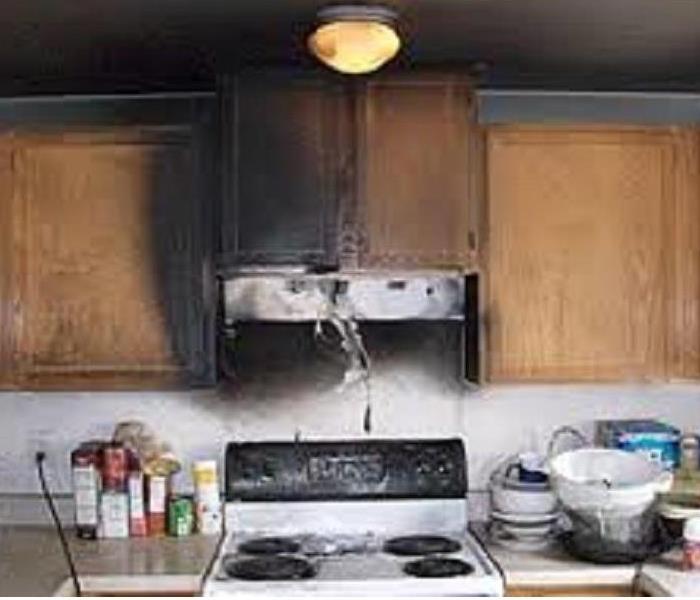 Smoke and Soot Damage Can Cause a Pervasive Odor in Your Suamico Home.
Smoke and Soot Damage Can Cause a Pervasive Odor in Your Suamico Home.
Smoke and Soot Damage Can Cause a Pervasive Odor in Your Suamico Home.
Smoke and soot is very invasive and can penetrate various cavities within your home, causing hidden damage and odor. Our smoke damage expertise and experience allows us to inspect and accurately assess the extent of the damage to develop a comprehensive plan of action.
Smoke and soot facts:
- Hot smoke migrates to cooler areas and upper levels of a structure.
- Smoke flows around plumbing systems, seeping through the holes used by pipes to go from floor to floor.
- The type of smoke may greatly affect the restoration process.
Different Types of Smoke
There are two different types of smoke–wet and dry. As a result, there are different types of soot residue after a fire. Before restoration begins, SERVPRO of West Brown Countywill test the soot to determine which type of smoke damage occurred. The cleaning procedures will then be based on the information identified during pretesting. Here is some additional information:
Wet Smoke – Plastic and Rubber
- Low heat, smoldering, pungent odor, sticky, smeary. Smoke webs are more difficult to clean.
Dry Smoke – Paper and Wood
- Fast burning, high temperatures, heat rises therefore smoke rises.
Protein Fire Residue – Produced by evaporation of material rather than from a fire
- Virtually invisible, discolors paints and varnishes, extreme pungent odor.
Our Fire Damage Restoration Services
Since each smoke and fire damage situation is a little different, each one requires a unique solution tailored for the specific conditions. We have the equipment, expertise, and experience to restore your fire and smoke damage. We will also treat your family with empathy and respect and your property with care.
Have Questions about Fire, Smoke, or Soot Damage?
Call Us Today – 920-434-8224


 24/7 Emergency Service
24/7 Emergency Service




















